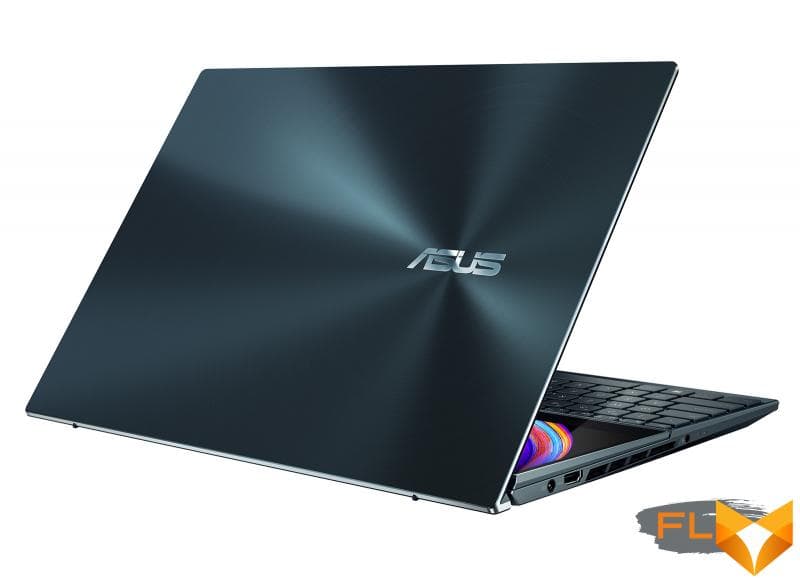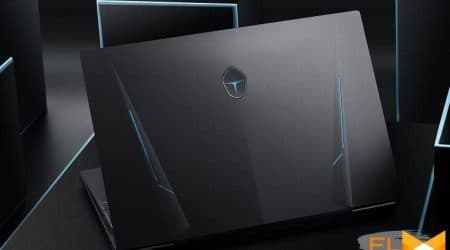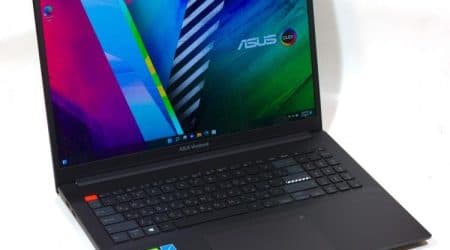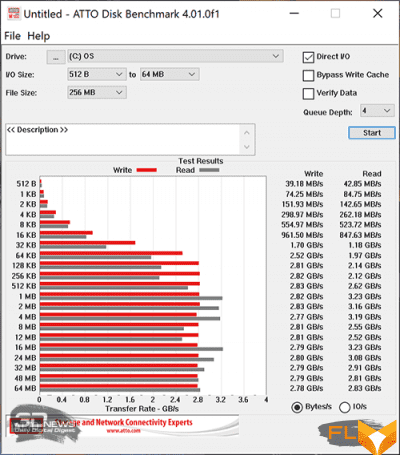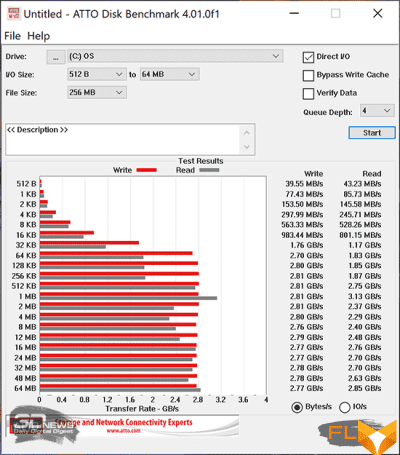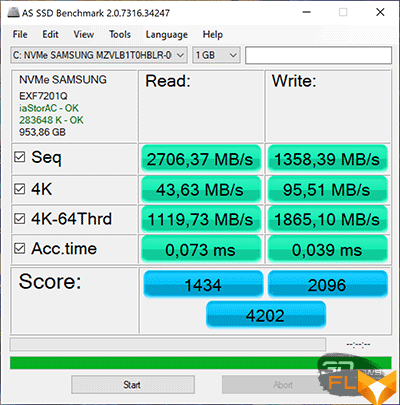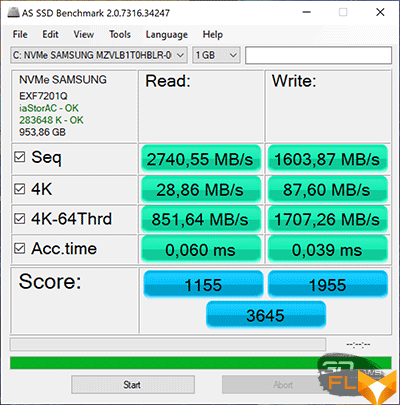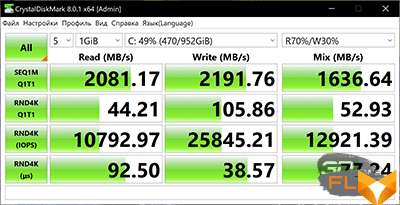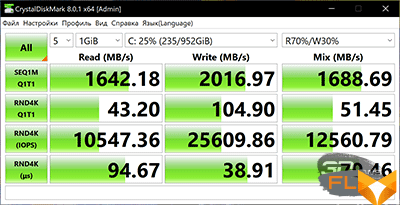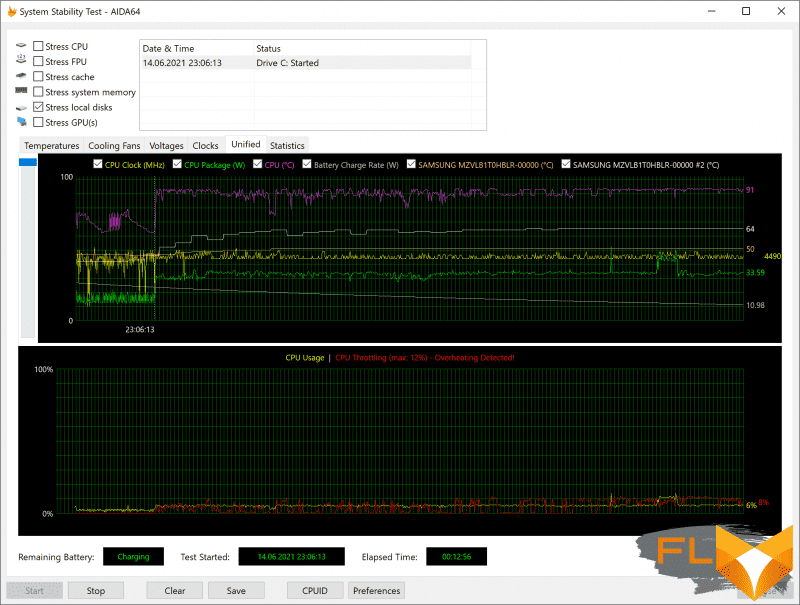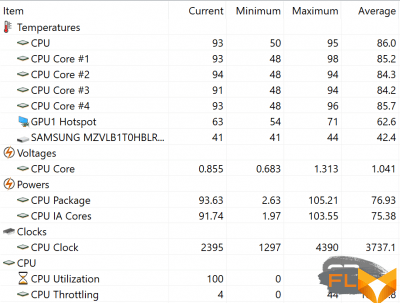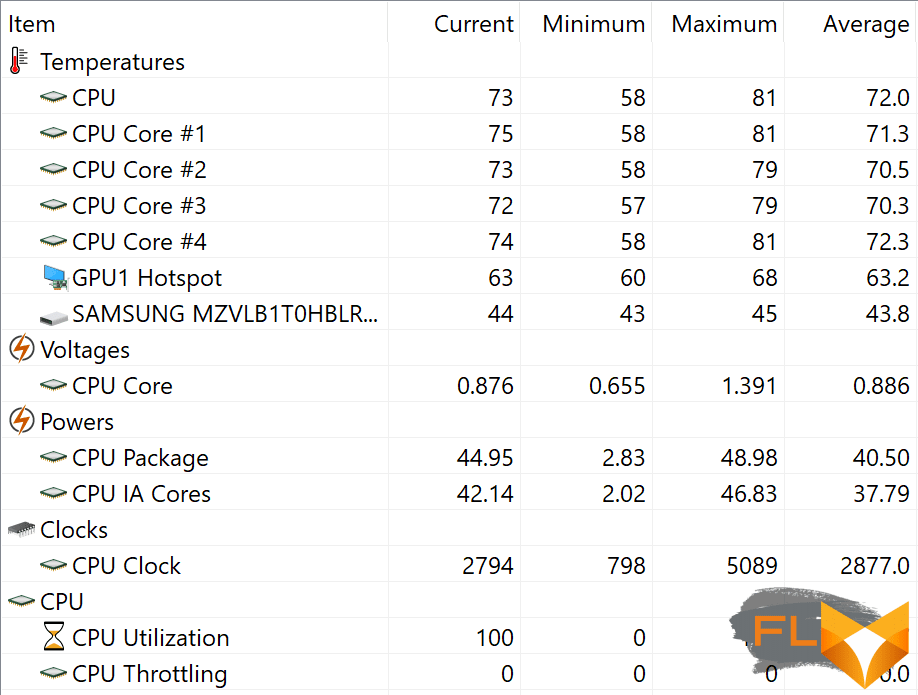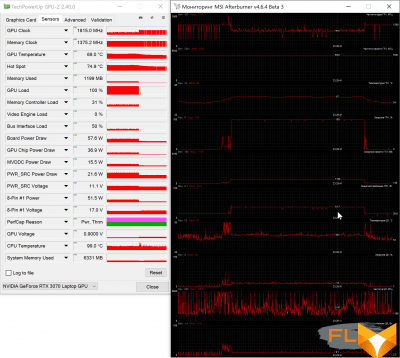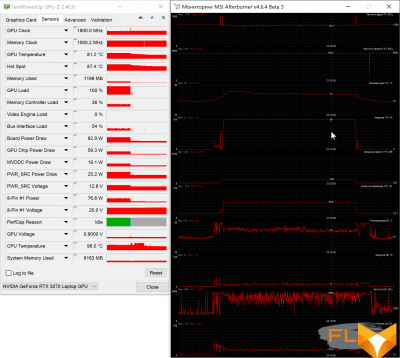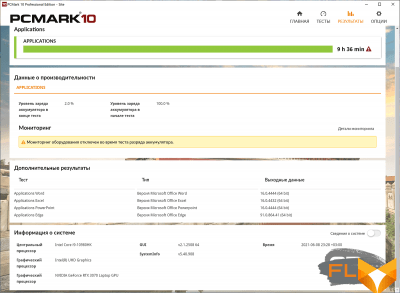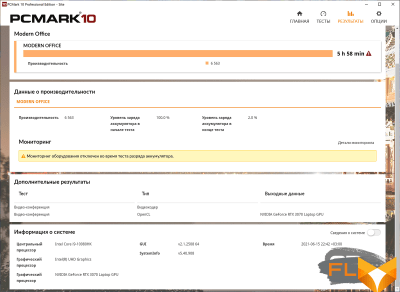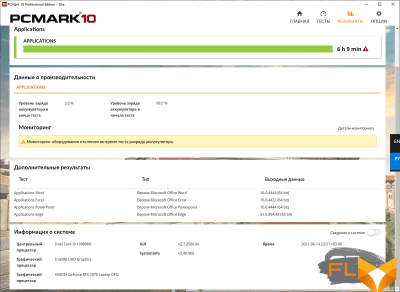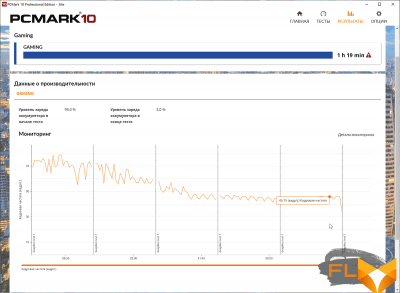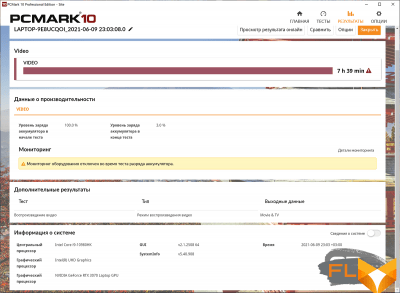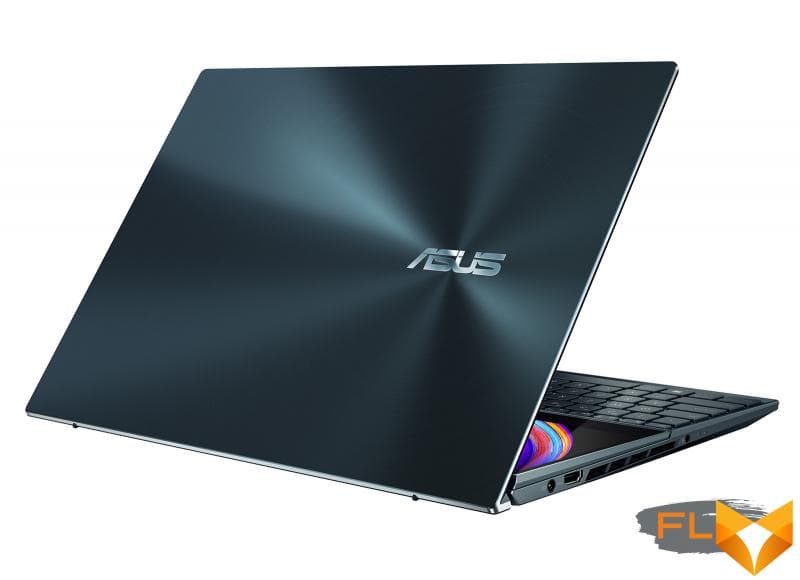


In the spring of 2021, we tested the ASUS ZenBook Duo 14 UX482 laptop equipped with an additional ScreenPad Plus display. Although this model is equipped with sufficiently productive components, including an Intel Core i7-1165G7 processor and 32 GB of LPDDR4X-4266 RAM, it is not suitable for games, and its display is made using IPS technology. With the new ZenBook Pro Duo 15 OLED UX582L, ASUS decided to go for broke and not only increased the display diagonal from 14 to 15.6 inches, but also chose OLED as a matrix, and also built a laptop hardware configuration on some of the most productive components.
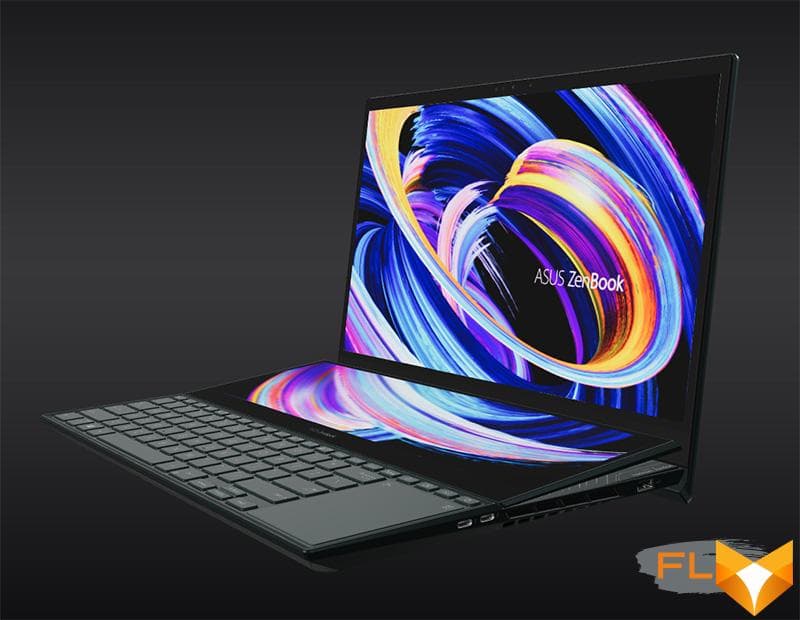
ASUS ZenBook Pro Duo 15 OLED UX582L is similar to two other models: both the already mentioned ZenBook Duo 14 UX482 and the year before last ZenBook Pro Duo UX581. And in fact, this is the development of the ideas of “fifteen” with the use of new developments that are familiar to us from a 14-inch laptop. Let’s take a closer look at the new product and test it comprehensively.
⇡#Box and accessories
The laptop comes in a black cardboard box with a plastic carrying handle. There is a minimum of useful information on the front and back sides of the box: only the motto and the name of the manufacturer.

But at the end of the box there is a detailed information sticker listing the configuration features of the laptop, barcodes and serial number.
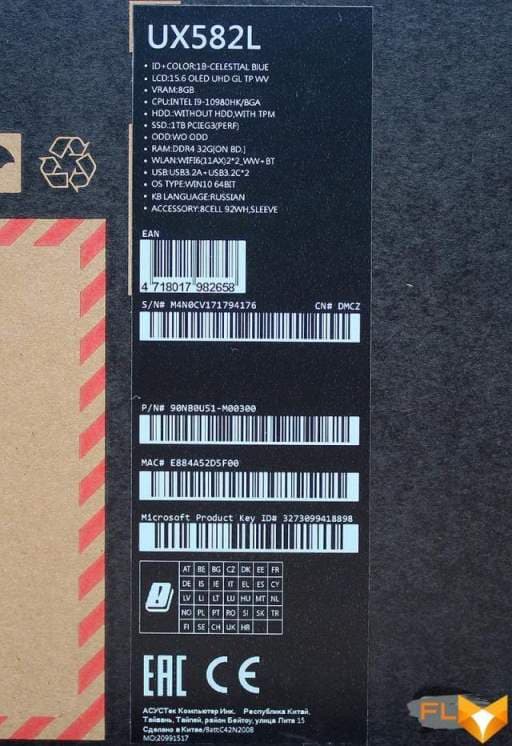
Inside the cardboard package, between the soft corners, another flat box is inserted, where the ultrabook is placed, and with it you can find a box with a power supply and a power cable, an envelope case with orange stitching, a palm rest and a stand for the ErgoLift Stand laptop itself. .
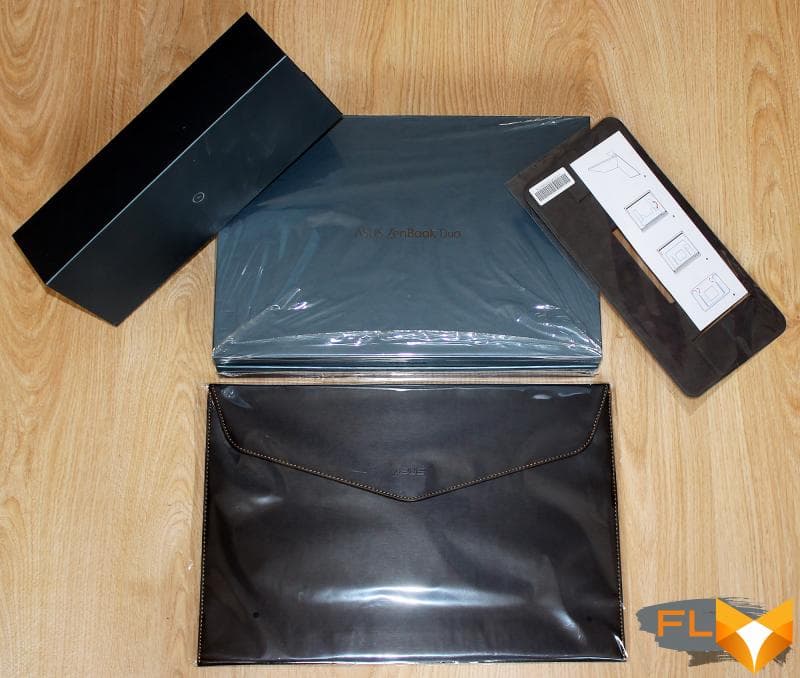
In addition, the kit includes instructions, a memo and an ASUS Pen stylus for working with touch displays.
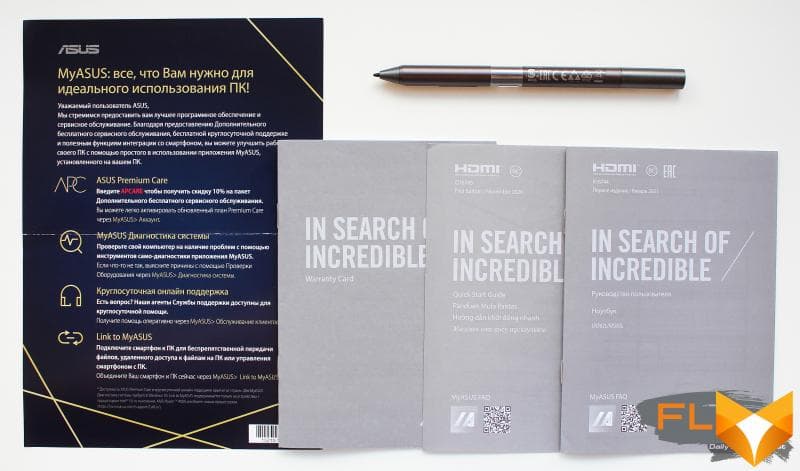

ASUS ZenBook Pro Duo 15 OLED UX582L manufactured in China comes with a two-year warranty. We have a flagship version of the laptop in our tests, so its price is high – 4500 dollars. A version with a less productive processor, half the amount of RAM and a drive costs 254 thousand rubles. The specific differences between them are given in the next section of the article.
⇡#Specifications
| ASUS ZenBook Pro Duo 15 OLED UX582L | ||
|---|---|---|
| Processor | Intel Core i9-10980HK (14 nm, 8 cores/16 threads, 2.4-5.3 GHz, 16 MB L3 cache, TDP 45-65 W) in other configurations – Intel Core i7-10870H | |
| Chipset | Comet Lake HM470 | |
| RAM | 32 (2 × 16) GB DDR4-2933 MHz (dual channel, 21-21-21-47 CR2) other configurations – 16 (2 × 8) GB DDR4-2933 MHz | |
| Video Subsystem | 1) Intel UHD Graphics integrated into processor 2) NVIDIA GeForce RTX 3070 Laptop GPU (8GB, 110W) | |
| Accumulators | 1TB SSD Samsung PM981a (MZVLB1T0HBLR-00000), NVMe 3.0 x4 M.2 other configurations – 512 GB SSD | |
| Display | 1) NanoEdge 15.6″ OLED UHD (3840 x 2160) Thin Bezel Touchscreen Display, 60Hz, 440nits, 1000000:1, 0.2ms, DCI-P3 100%, Anti-Glare, Pantone Certified Validated and TÜV Rheinland; 2) ScreenPad Plus 14″ IPS 4K (3840 × 1100) 400 nits 1,000,000:1 touchscreen | |
| Sound subsystem | Realtek ALC3288 audio codec; two stereo speakers; Harman Kardon certification; 4 microphones with support for voice control Cortana and Alexa | |
| Cart Reader | No | |
| Network interfaces | Cable network | No |
| Wireless | Intel Wi-Fi 6 AX201D2W 802.11ax, MIMO 2×2, 2.4 and 5.0 GHz (160 MHz) | |
| Bluetooth | Bluetooth 5.0 | |
| NFC | No | |
| Interfaces and Ports | USB 2.0 | No |
| USB 3.2 Gen2 | 1 Type-A | |
| USB 3.1 Gen2 | 2 Type-C (Thunderbolt 3, up to 40Gbps) | |
| HDMI | Yes, 2.1 | |
| VGA | No | |
| DisplayPort 1.4 | No | |
| RJ-45 | No | |
| Microphone input | Yes (combined) | |
| Headphone output | Yes (combined) | |
| Input Devices | Keyboard | Membrane, with backlight and function keys, key travel ~1.4 mm |
| Touchpad | Two-button NumberPad 2.0, 62 × 86 mm | |
| VoIP | Webcam | HD (30 FPS@720p) + IR with Windows Hello |
| Microphone | Yes, 4 pcs | |
| Battery | 92 Wh (5984 mAh), 8 cells, Li-ion | |
| Power adapter | ADP-240EB (240W, 20.0V, 3.5A), 559g, with 1.18m built-in cable and 1.75m power cable | |
| Dimensions | 359.8 × 249.2 × 21.5 mm (thickness including feet 25.0 mm) | |
| Weight without power adapter: declared/measured | 2340 / 2405g | |
| Body color | Celestial Blue | |
| Other features | MIL-STD 810H compliant; Trusted Platform Module (TPM); myASUS; ScreenXpert; McAfee | |
| Operating system | Windows 10 Pro/Home | |
| Warranty | 2 years | |
| Retail value | $4,500 | |
Hull design and ergonomics
When unpacking the ASUS ZenBook Pro Duo 15 OLED UX582L, you find that an information sticker with pictograms marking the key features of the device is glued to its front end.
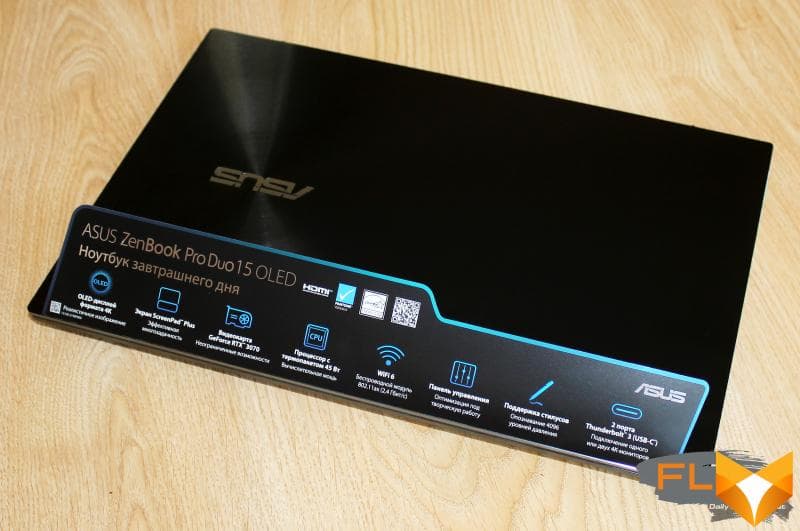
The laptop is offered in a single color with the original name Celestial Blue – gray with metallic tints, although the manufacturer calls this shade sky blue. Be that as it may, the laptop case looks very cool, even if it quickly loses its appearance due to fingerprints.
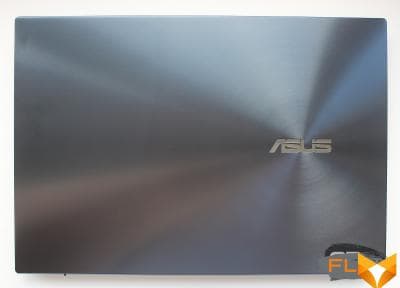 | 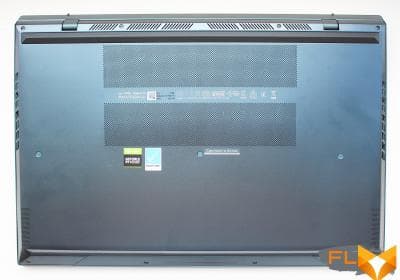 |
The screen cover and the working keyboard panel are made of lightweight and durable magnesium-aluminum alloy, and the base is made of plastic. On the top right is a silver ASUS logo, from which concentric circles diverge. This element, with minor changes, has been moving from one ZenBook model to another for ten years and makes them recognizable.
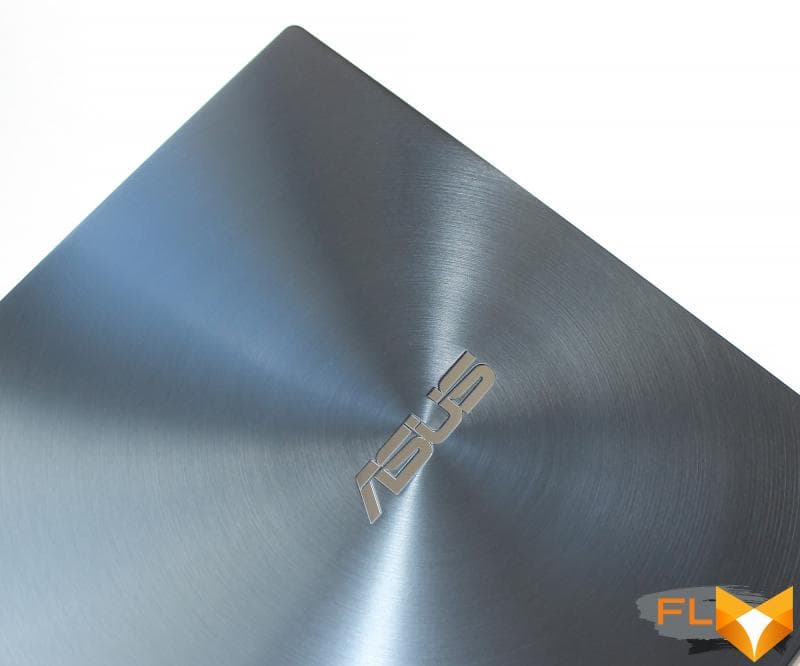
Also from the design solutions, we note the edges of the body with a mirror finish, reflecting light at different angles. Almost every detail of the case is given attention, which, as it were, emphasizes the premium level of the product.
The new ASUS ZenBook Pro Duo 15 OLED UX582L is 2.5mm thinner and 100 grams lighter than the ASUS ZenBook Pro Duo 15 UX581. Its dimensions are 359.8 × 249.2 × 21.5 mm and weighs 2405 grams.
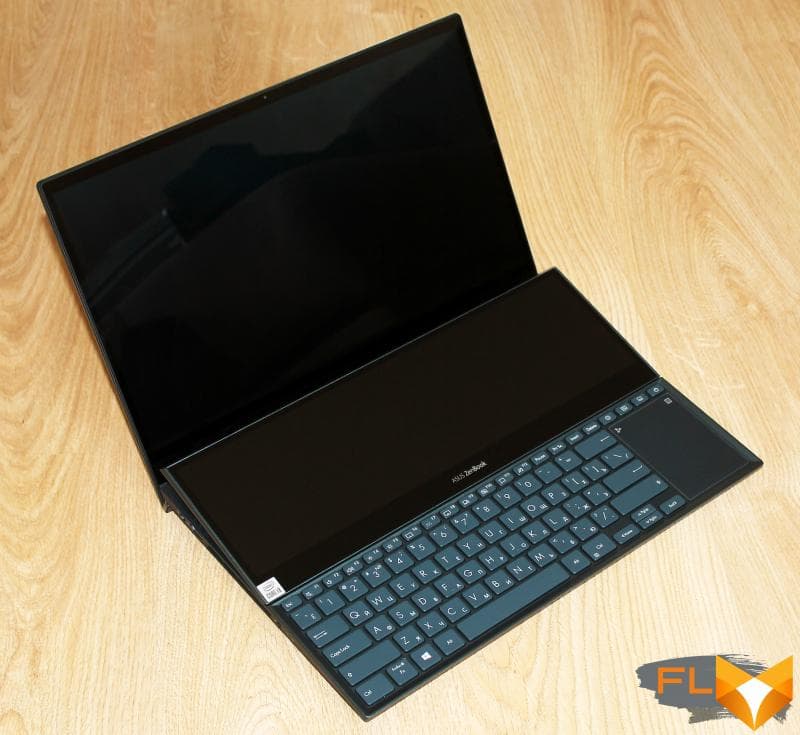
Those who happened to see the ASUS ZenBook Pro Duo for the first time will surely be surprised by the unusually narrow keyboard and the additional ScreenPad Plus screen above it, but for our regular readers this branded feature of the laptop will no longer be a novelty.
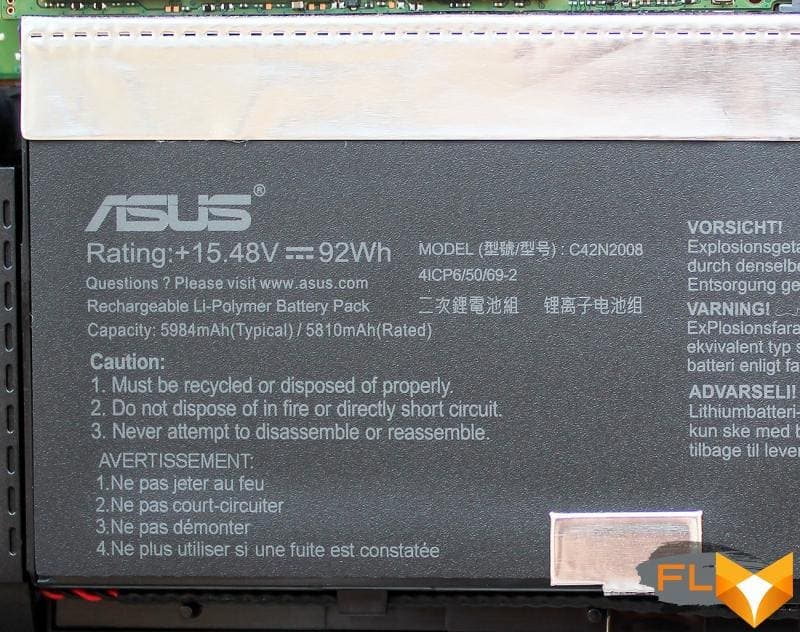
The panel with the display leans back by 150 degrees, and the additional screen rises by 9.5 degrees, visually forming a single work surface with the main one.
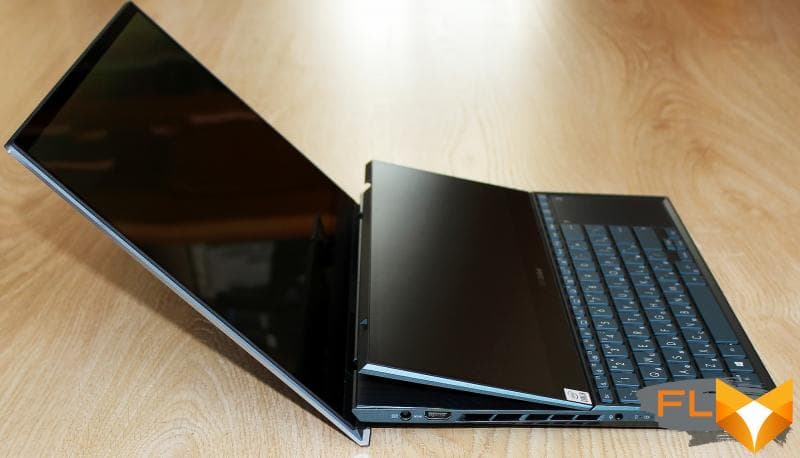
To prevent the edge of the top panel from scratching, plastic stops are provided in its lower end.
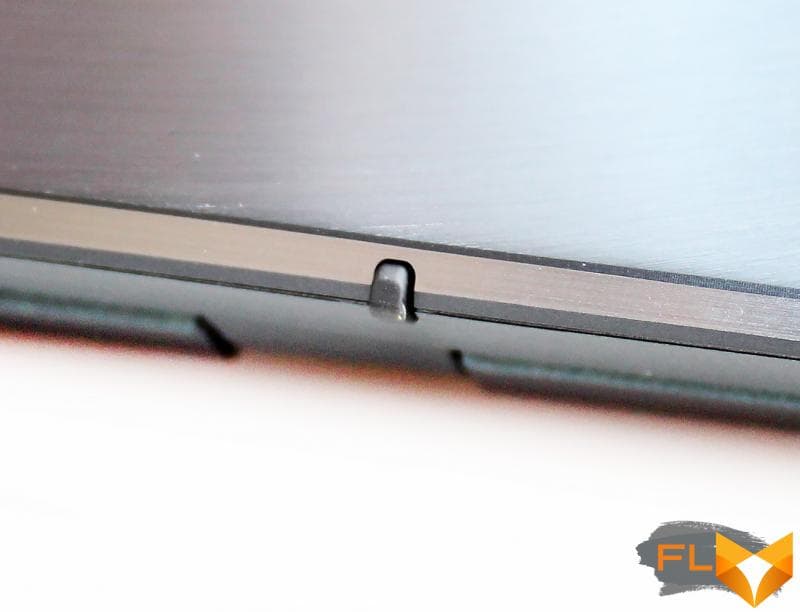
The laptop supports two long rubber strips glued to the front and back of the base. With them, the thickness of the laptop is 25 mm.

The front end of the laptop case does not contain any connectors and controls, but there is a barely noticeable LED strip on it, indicating the mode of operation of the laptop’s hardware component. We will talk about this later. We add that there is no notch for the fingers here either, however, due to the beveled front edge, it is convenient to open the screen, and you do not need to hold the base, even despite the tight ErgoLift screen hinges.
On the right side of the case, there are two USB 3.2 Gen2 Type-C ports of the Thunderbolt 3 interface (up to 40 Gb / s) with support for video output modes (DisplayPort) and power supply (Power Delivery), as well as one USB 3.2 Gen1 Type-A port (5 Gb / s). with).

In turn, the power connector, HDMI 2.1 video output, headphone and microphone combo jack, as well as storage and charge activity indicators are displayed on the left.


In our opinion, one more USB Type-A connector and a microSD card reader are missing here. However, this is due to the fact that a large area of the ends of the case was taken away by the massive ventilation grilles of the laptop cooling system, which are necessary for cooling a very serious hardware component.
ASUS highlights the fact that the laptop has received MIL-STD-810H certification and passed a whole series of additional ASUS internal tests.
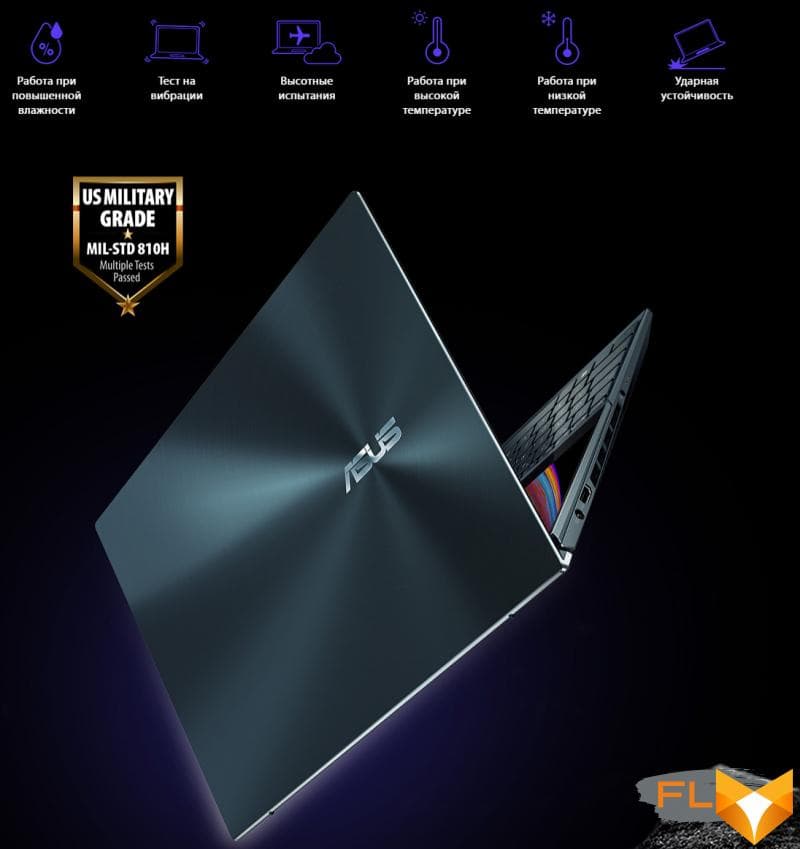
This is a rather important point, since such an expensive device simply has to be durable and reliable, so the company’s engineers pay close attention to such moments.
⇡#Input Devices
Apparently, the keyboard in the new ASUS ZenBook Pro Duo 15 OLED UX582L has not changed compared to what was in the previous 15.6-inch model. This is a compact membrane keyboard without a mechanical numeric keypad, shifted to the front edge of the operating panel.
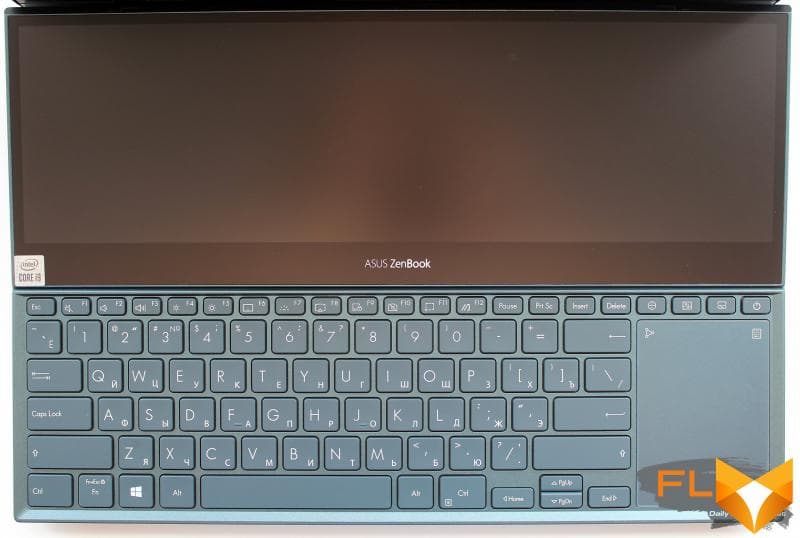
The key travel is 1.4 mm, the concavity is 0.15 mm, the pressing is soft and pleasant to the touch. The dimensions of the main keys are 15.0 × 14.0 mm, the functional keys are 12.0 × 7.0 mm. The increased Shift and Enter, as well as a fairly large space bar, make working at the keyboard comfortable, while small (narrow) arrows measuring 18.5 × 6.5 mm will take some getting used to.
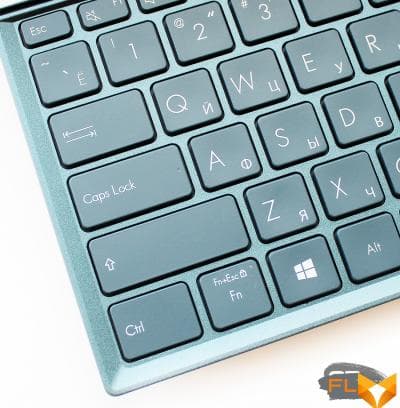 | 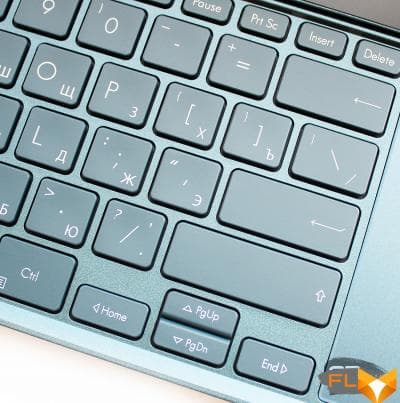 |
Since the keyboard is shifted to the front edge of the case, ASUS carefully provided a stand for a more comfortable position of the hands.
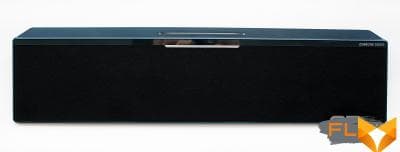 |  |
The keyboard has a white backlight with three levels of brightness. The first, however, is barely noticeable, but the other two make working on a laptop at night quite comfortable.
 |  |  |
The touchpad, measuring 62 × 86 mm, is located on the right and is equipped with two dedicated buttons.
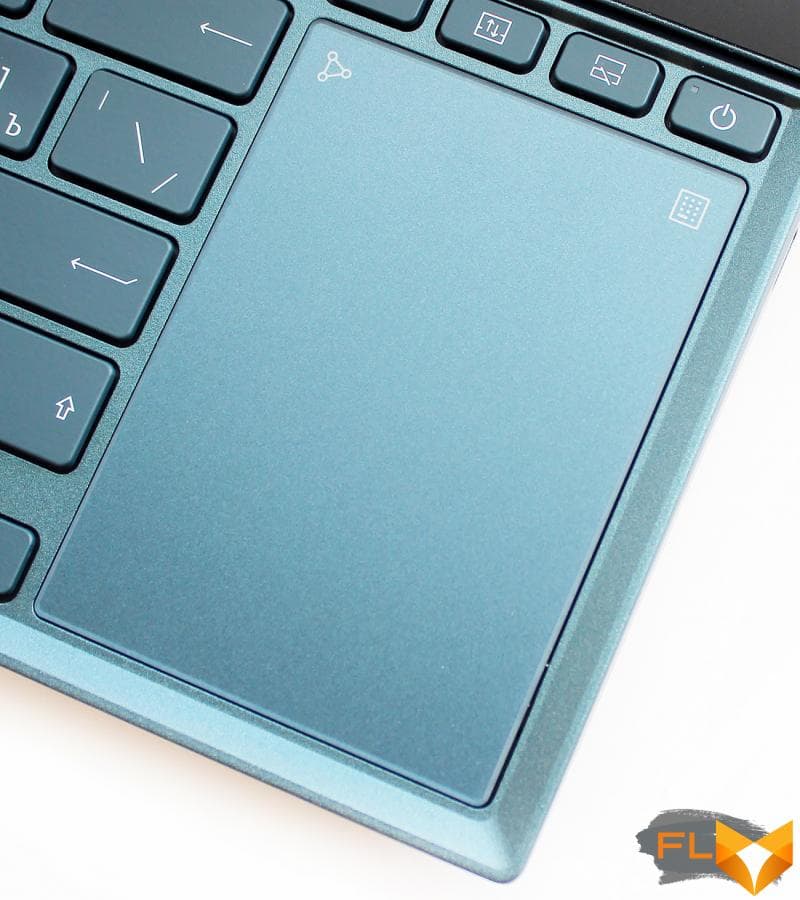
The surface is smooth and very sensitive. After getting used to the non-standard location and vertical shape of the touchpad, it becomes convenient to work with it. By pressing the touch button in the upper right corner, the touchpad turns into NumberPad 2.0.
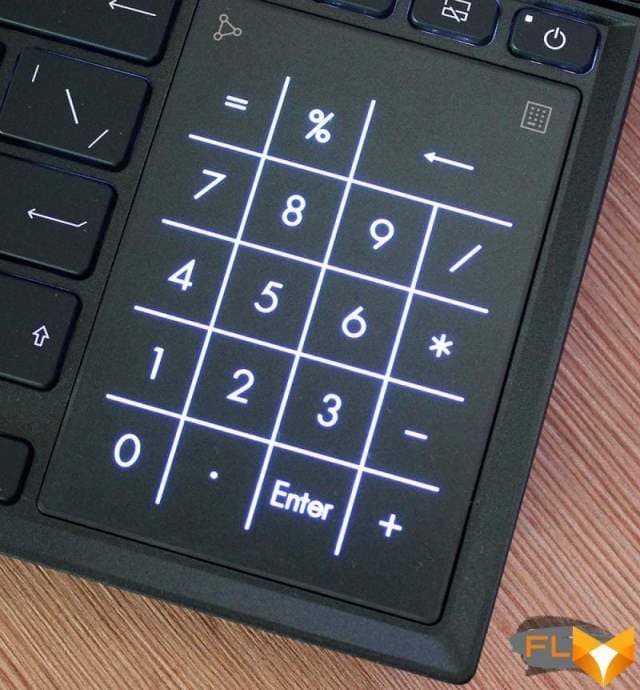
The laptop’s 720p webcam is built into the center of the display’s top bezel.
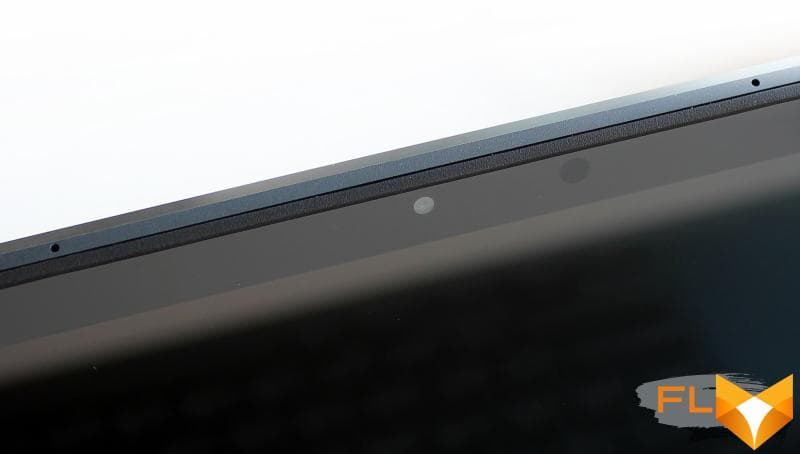
Supports biometric face recognition Windows Hello, working even in the dark thanks to the built-in infrared sensor.
Display and ScreenPad Plus
Structurally, both displays are not frameless: the side frames are 7.0 mm, and the top one is 9.0 mm. However, all the frames are under glass, which completely conceals their presence, and the impression of framelessness is really created.

The main NanoEdge sensor matrix is made using OLED technology, has a resolution of 3840 × 2160 pixels (4K) with HDR support, a declared brightness of 440 nits and operates at a frequency of 60 Hz. The claimed response time is 0.2 ms.

Claimed 100% DCI-P3 cinematic color gamut and exceptional color accuracy (ΔE
We tested the laptop’s main display with an X-Rite i1 Display Pro calibrator and Argyll CMS software with a DispcalGUI GUI. All measurements were taken without additional display calibration, but the laptop already comes with a proprietary calibration profile using ASUS Calibration technology, which we did not remove. Let’s look at the results.
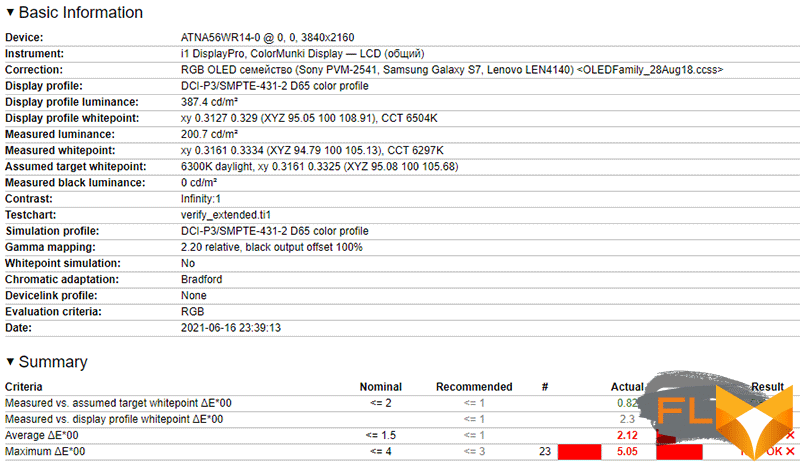
We got the average value of DeltaE deviations a little higher than the deuce declared in the characteristics – 2.12, and the maximum turned out to be 5.05 units, but this is the only exceptional case in the measurement table.
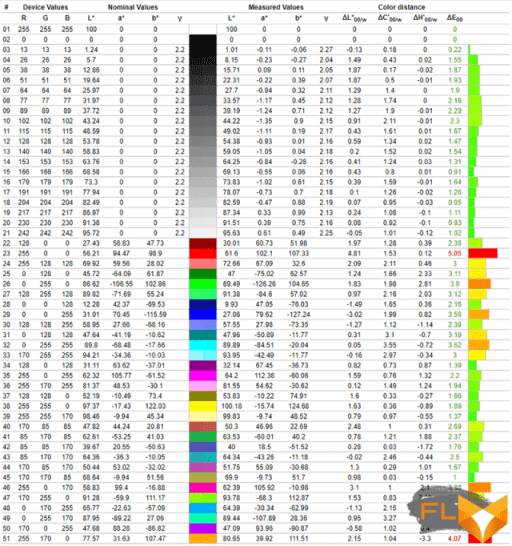
The color temperature of the main display of the laptop almost copies the reference value of 6500 K.
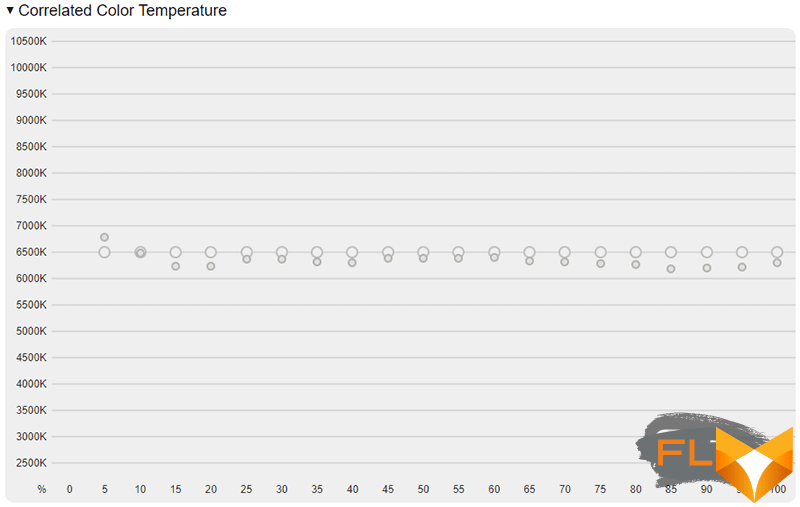
The gamma curve runs in the range from 2.05 to 2.25, which is also a good indicator.
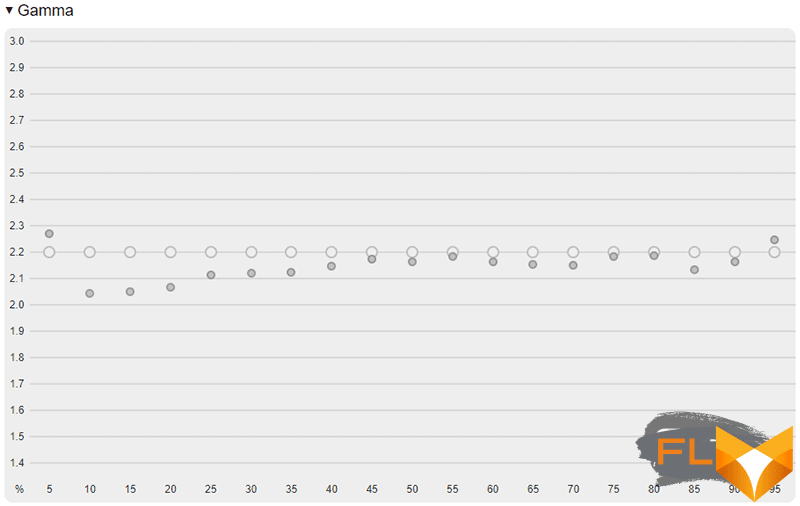
The deviations of the color balance in the gray gradient do not exceed 5%.

After calibration, the average DeltaE deviation of the OLED matrix of the laptop was only 0.08 units, and the maximum was 1.52 units. The sRGB, Adobe RGB, and DCI P3 color spaces are 100.0%, 96.9%, and 99.9%, respectively.
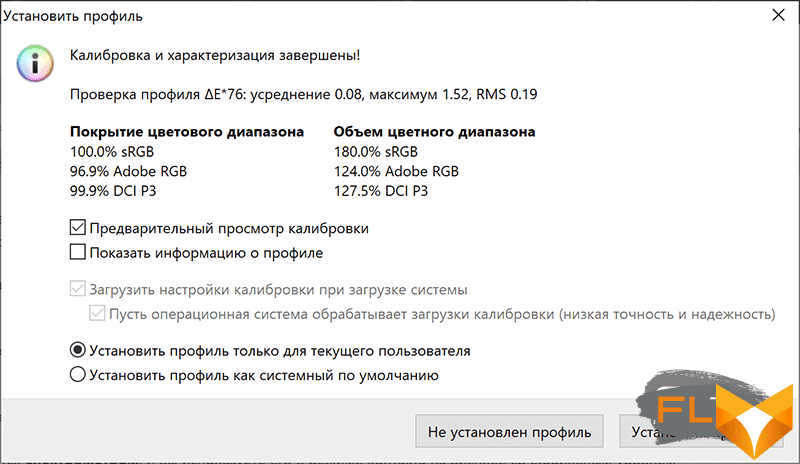
But the maximum brightness of OLED ASUS ZenBook Pro Duo 15 OLED UX582L was only 388 cd/m2, which is noticeably lower than the 440 cd/m2 stated in the specifications. sup>. The minimum value turned out to be 5 cd/m2.
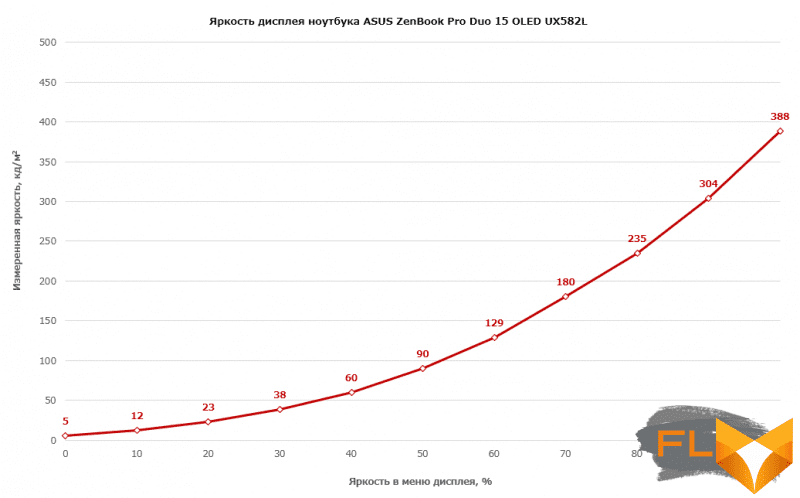
If we take into account the type of display (in OLED, we recall that each pixel glows individually), the backlight uniformity could not be measured, but purely for practice, we carried out such measurements, making sure it was ideal.
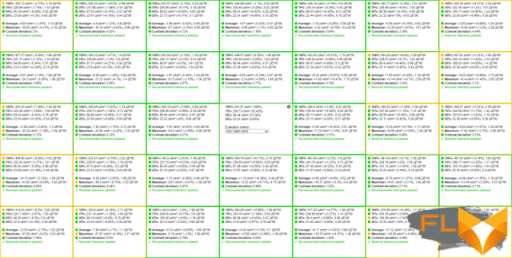
As for me, the main OLED display of the ASUS ZenBook Pro Duo 15 OLED UX582L laptop is the benchmark among mobile computer displays. You will meet the same color reproduction, brightness and perfect clarity, to put it mildly, infrequently, even in models worth almost three hundred thousand rubles.
As for the so-called poisonousness of the OLED color gamut (true for any displays of this type), ASUS also thought about users here, providing for the possibility of adjusting it in the proprietary MyASUS application.
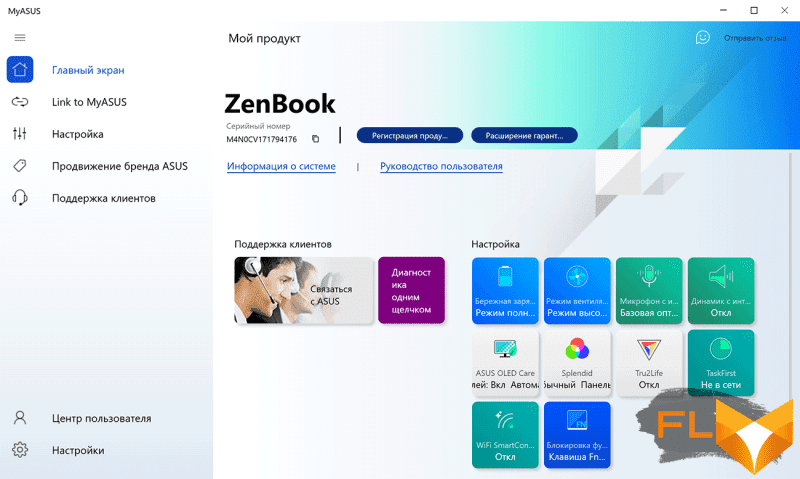
As in ASUS ZenBook Duo 14 UX482, here the color scheme can be changed separately for the main display and separately for the ScreenPad Plus panel.
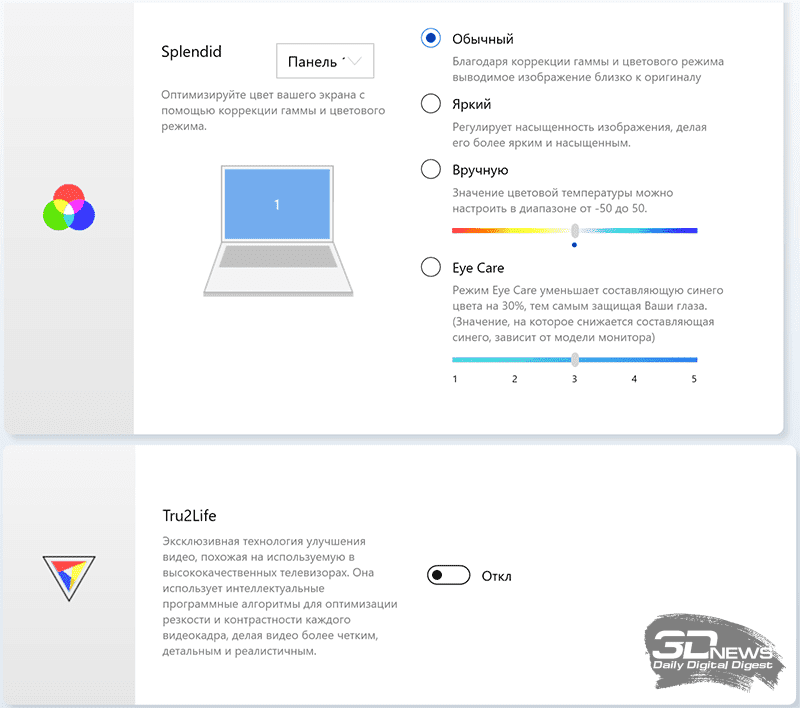
In addition, it is possible to protect the OLED display from burn-in, the corresponding section with settings in MyASUS is called ASUS OLED Care.
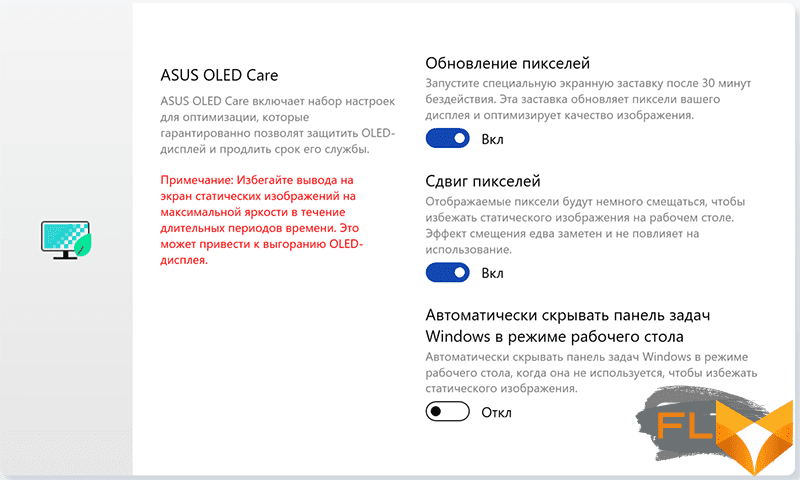
Also in the ProArt Creator Hub application (preinstalled on the laptop), you can calibrate the display, which will require the appropriate tool.
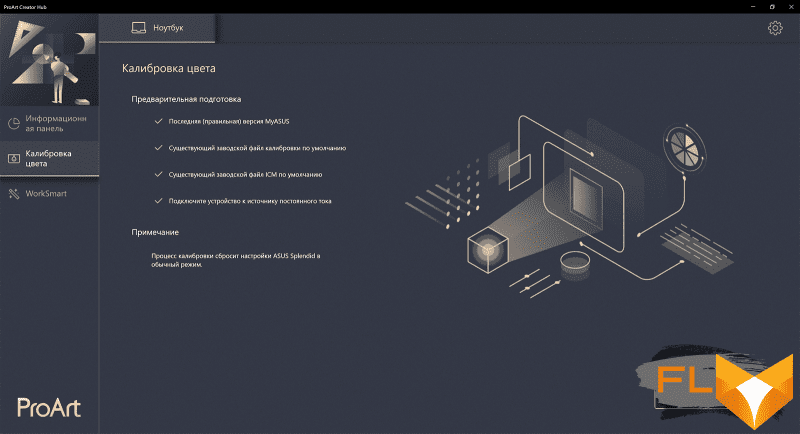
As for the optional ScreenPad Plus touch display, it is based on a 14-inch IPS-matrix with a resolution of 3840 × 1100 pixels. The maximum declared brightness is 400 cd/m2.
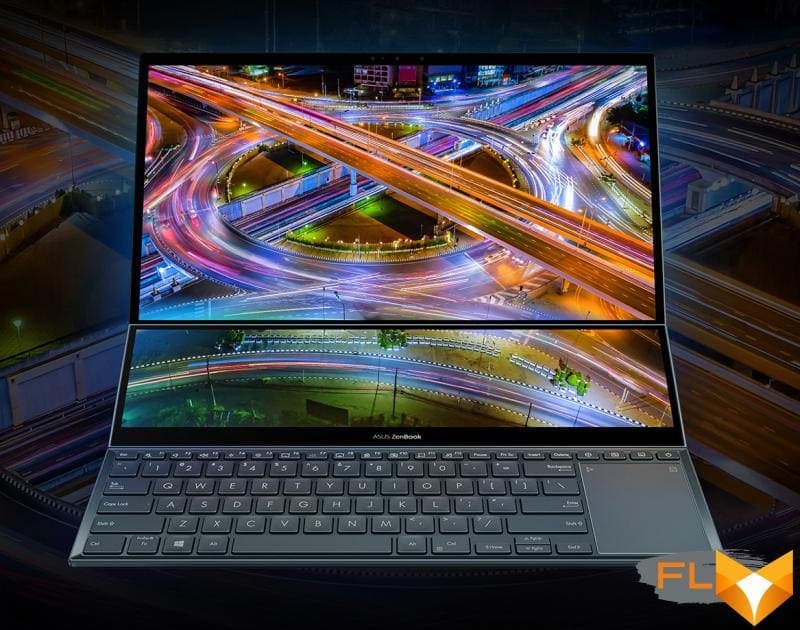
As you already know, when you open the main display, the secondary ScreenPad Plus rises by 9.5 degrees, creating the effect of combining two screens into one. True, there is also a specificity here: in order to achieve this, it is also necessary to adjust the height of the chair and the angle of inclination, depending on the height of the user and his usual position at work. In other words, just opening the lid so that both displays immediately merge into a single whole will not work, adjustment is still required. However, it is for this that the kit includes a stand, which greatly simplifies this process.
Setting up an additional display is implemented through the menu called by the key in the column on the left. There you can also customize the menu itself, as well as open detailed help for working with ScreenPad Plus with examples.
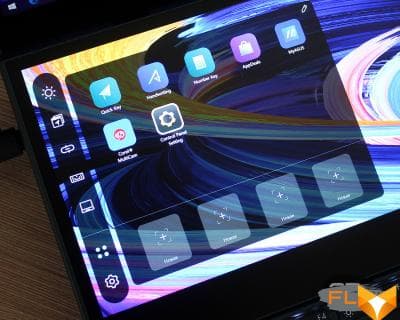 | 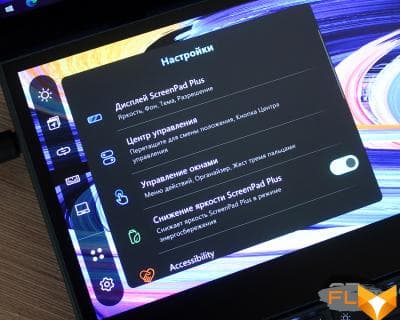 |
Another feature of the new ASUS ZenBook Pro Duo 15 OLED UX582L is a special panel that expands the possibilities for working with programs from the Adobe family.
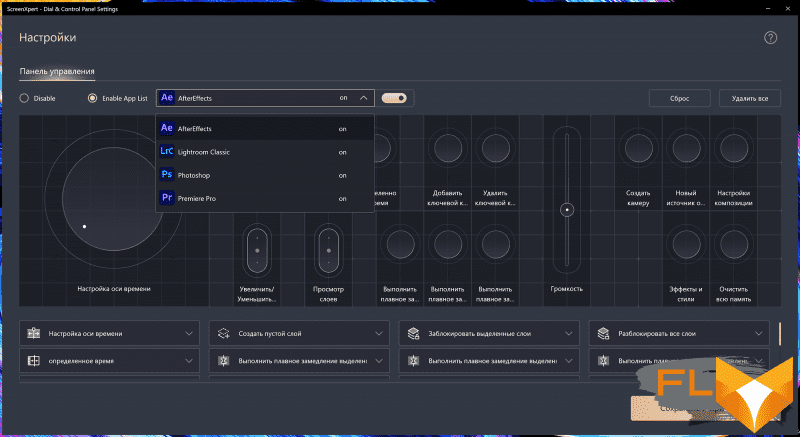
It can be configured to suit your requirements and displayed on ScreenPad Plus, which makes working with, for example, the same Adobe AfterEffects much more convenient.
You are already familiar with the capabilities of the ScreenPad Plus from our previous articles on ASUS ZenBook Pro Duo laptops, and they are also quite fully described on the official laptop page. At the same time, we found the use of an additional display in games, placing on it monitoring programs that allow real-time monitoring of a huge number of parameters of the laptop’s hardware configuration.

Yes, some of them can also be displayed on the main screen using MSI Afterburner, but it’s much more convenient this way – extra numbers do not flicker before your eyes on the main screen. In general, the ScreenPad Plus is really useful, and you understand this especially when you get used to the ASUS ZenBook Pro Duo 15 OLED UX582L, and then switch to another laptop.
⇡#Internal device and accessories
The bottom panel of the laptop is made of plastic and can be removed entirely, which will require unscrewing a few Torx screws.
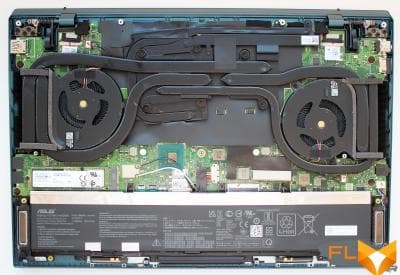 |  |
Under the bottom cover is a massive dual-circuit cooling system that covers most of the motherboard, as well as the battery along the entire length of the front of the case.
We will give brief characteristics of the main components of the laptop in the following screenshot from AIDA64 Extreme, and then we will analyze each component separately.
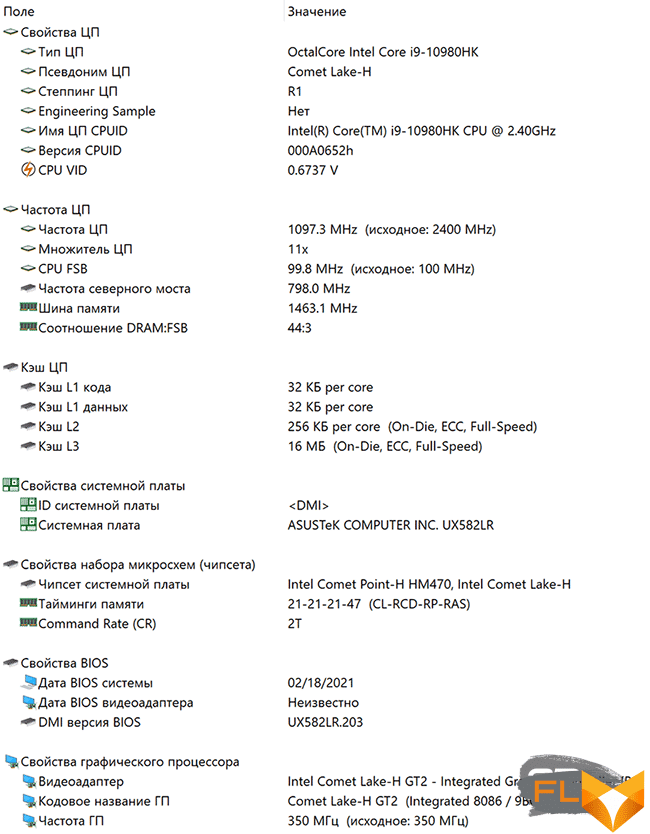
The laptop motherboard is based on the Intel Comet Lake HM470 chipset.
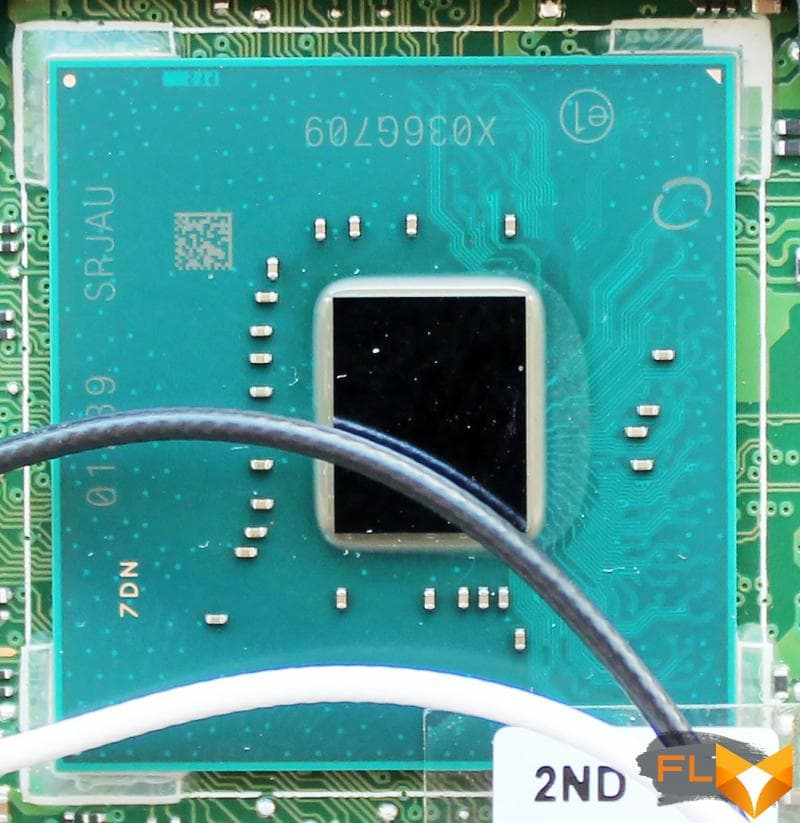
The BIOS version UX582LR.203 is dated February 18, 2021, there were no more recent versions at the time of writing.
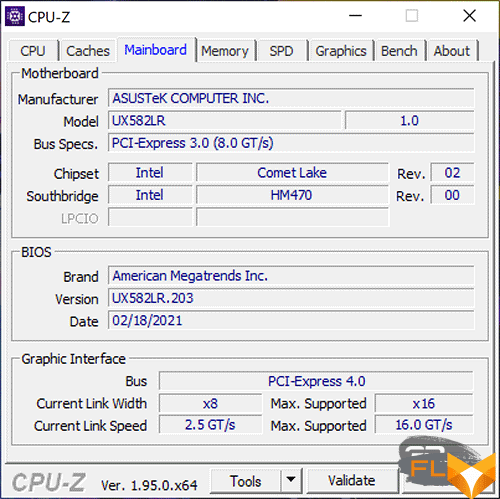
As the processor in our version of ASUS ZenBook Pro Duo 15 OLED UX582L, the flagship eight-core and sixteen-thread Intel Core i9-10980HK, released according to the 14-nm process technology, is used.
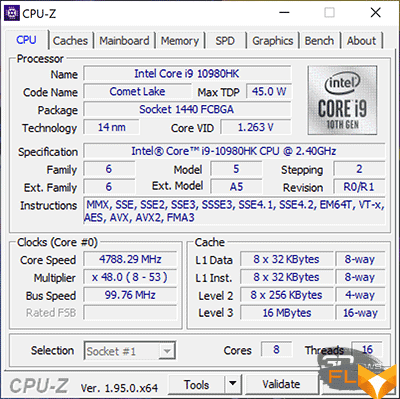 | 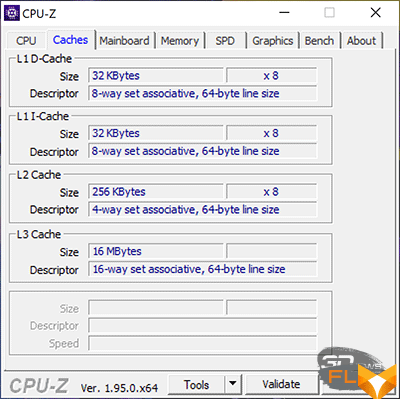 |
Its base frequency is 2.4 GHz, but in turbo mode it can increase to up to 5.3 GHz. L3 cache is 16 MB and peak heat dissipation can be up to 65 watts (45 watts typical). A slightly simpler and less expensive version of this laptop uses an Intel Core i7-10870H processor, inferior to the flagship only in its maximum turbo frequency of 5.0 GHz.
The amount of DDR4 RAM in this laptop model can be equal to 16 or 32 GB, as in our case. The memory is soldered on the board, so it cannot be increased.
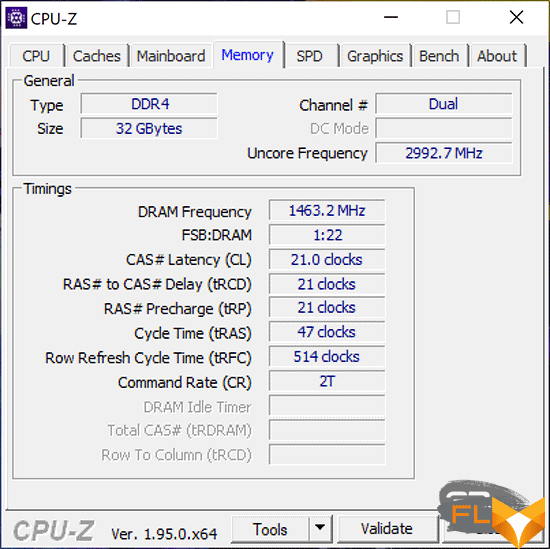
The effective frequency of the chips is 2933 MHz with timings of 21-21-21-47 CR2.
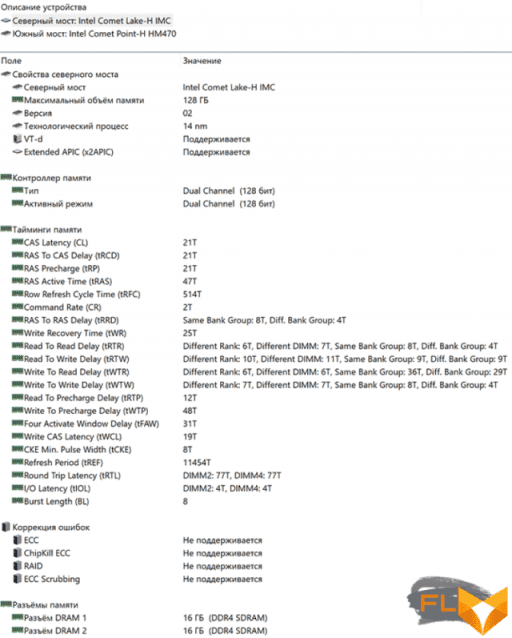
The bandwidth and latency of the memory are quite average by modern standards, and with a laptop of this level they are not at all compatible.

We once again draw the attention of ASUS and other laptop manufacturers that in flagship models, and even more so in gaming laptops, to which ASUS ZenBook Pro Duo 15 OLED UX582L also belongs, users would like to see memory with a frequency of at least 3.2 GHz and main timings 16 and below. This will significantly improve the level of comfort in 3D games and performance in resource-intensive applications.
The laptop has two graphics cores. Built into the processor, Intel UHD Graphics delivers 2D performance and saves battery power. The discrete NVIDIA GeForce RTX 3070 Laptop GPU is responsible for gaming performance.
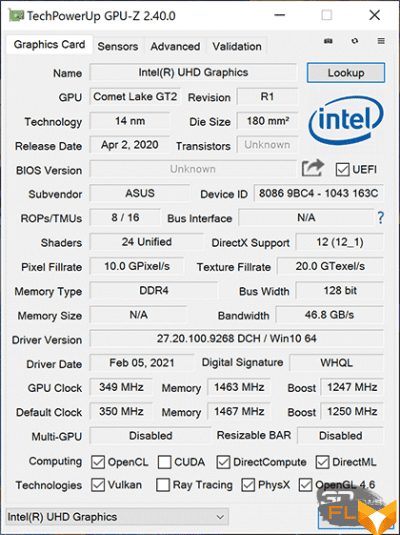 | 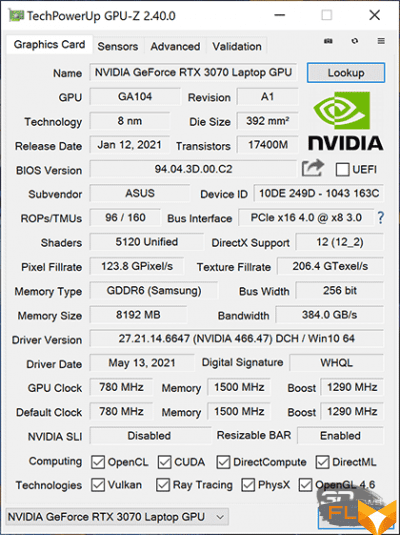 |
The declared TDP level for the video card is 110W in Dynamic Boost mode, and the core frequency should reach 1.44 GHz. The amount of video memory is 8 GB, and its effective frequency is 12 GHz.
ASUS ZenBook Pro Duo 15 OLED UX582L can be equipped with 512 GB or 1 TB drives. In the latter case, this is a fast NVMe SSD Samsung PM981a (MZVLB1T0HBLR-00000) in the M.2 2280 form factor.
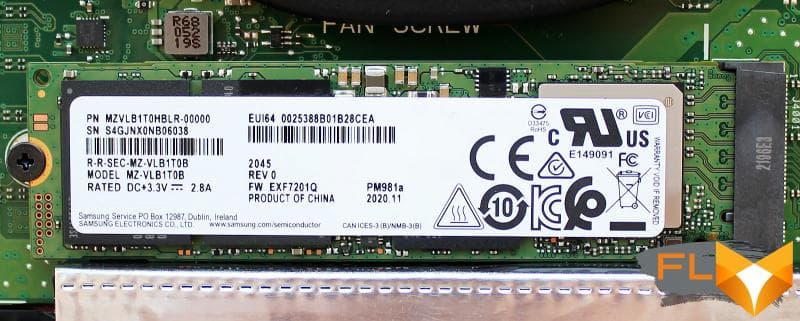
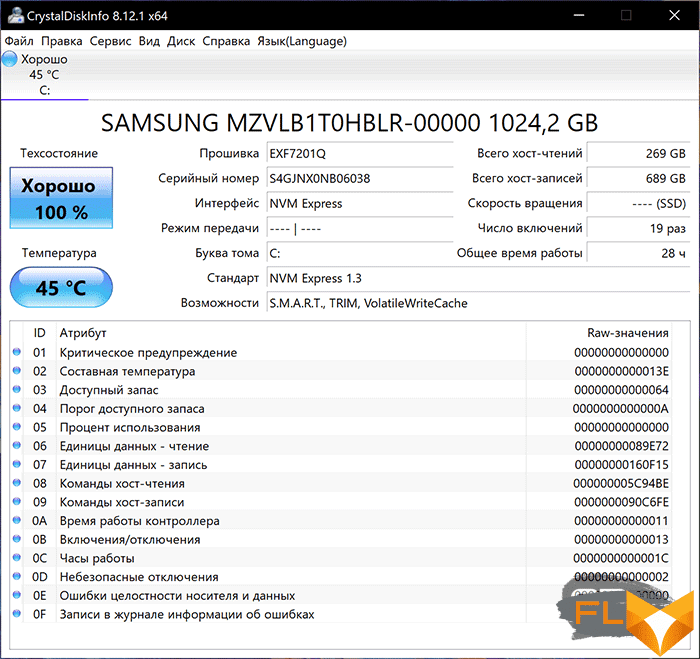
According to the test results, the performance of the drive when the laptop is running from the mains is higher than when it is offline from the battery, but the difference is not critical.
| ATTO Disk Benchmark (plugged in) | ATTO Disk Benchmark (battery powered) |
| AS SSD Benchmark (plugged in) | AS SSD Benchmark (battery powered) |
| CrystalDiskMark (plugged in) | CrystalDiskMark (battery powered) |
The temperature regime of the drive is monitored by two sensors. According to one of them in the stress test, the maximum temperature reached 64 degrees Celsius, and according to the second – 50 degrees Celsius.
SSD stress test on AC power
In normal work with a laptop or in games, the drive does not warm up above 53 degrees Celsius according to the “hottest” sensor. These are normal figures for high-performance laptop models and their SSDs.
ASUS ZenBook Pro Duo 15 OLED UX582L is equipped with only a wireless communication module, the role of which is played by the Intel AX201D2W chip with support for Wi-Fi 6 (802.11ax), MIMO 2 × 2 and the ability to operate at frequencies of 2.4 GHz and 5.0 GHz ( bandwidth 160 MHz).
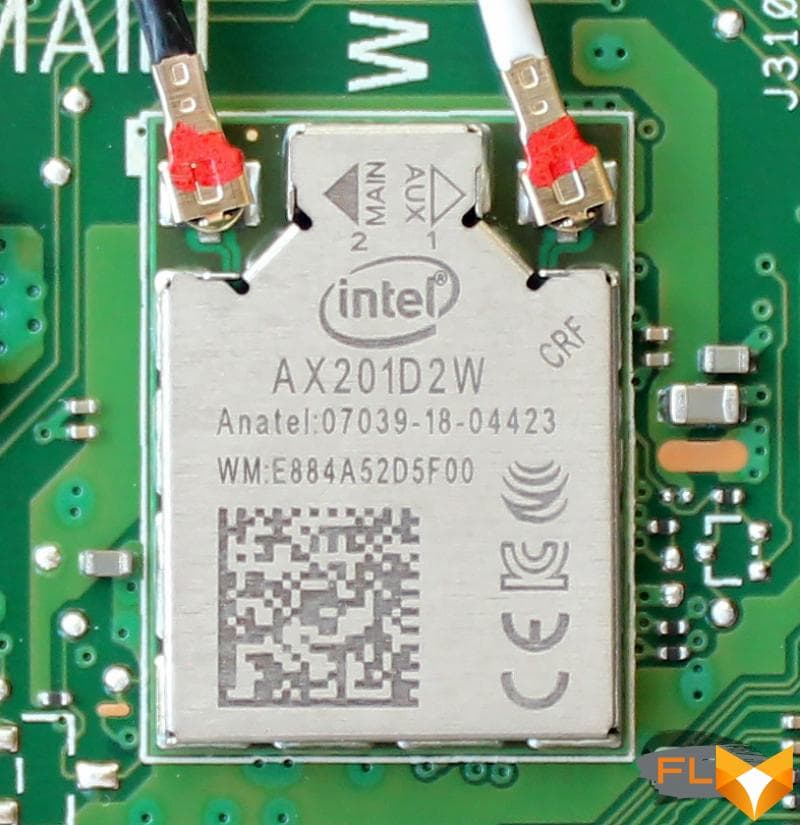
The receiver antennas are built into the front of the case.
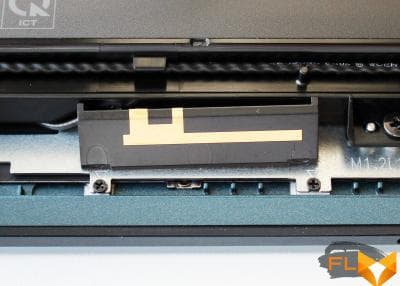 | 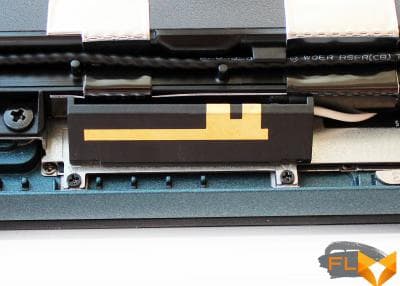 |
The TaskFirst and WiFi SmartConnect functions from the MyASUS kit are responsible for traffic prioritization.
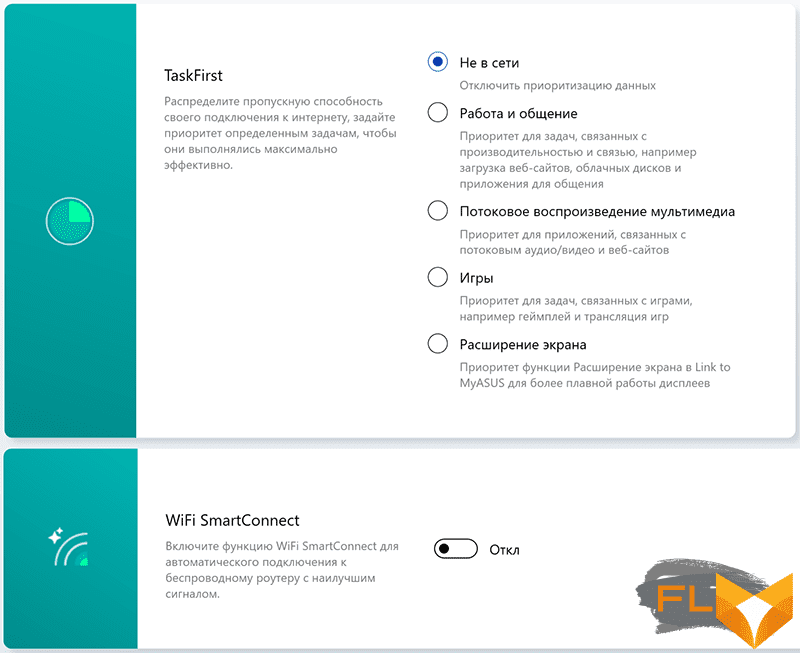
The audio path of the laptop called SonicMaster is based on the Realtek ALC3288 audio processor, and Harman Kardon specialists took part in the development of the sound system.
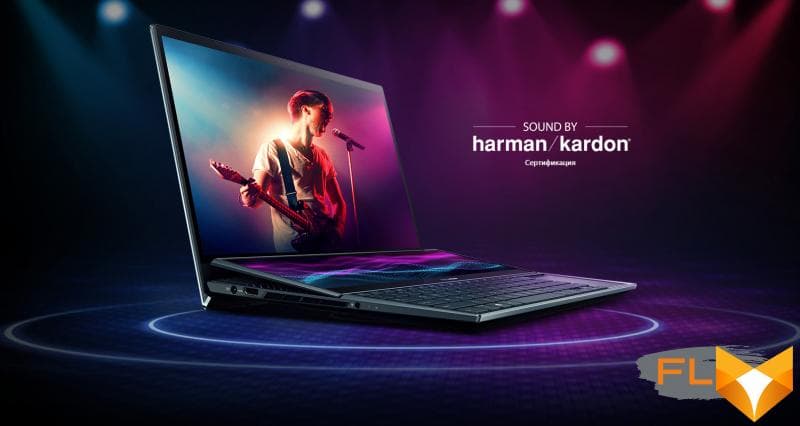
Two stereo speakers are built into the base of the notebook in close proximity to the side bevels.
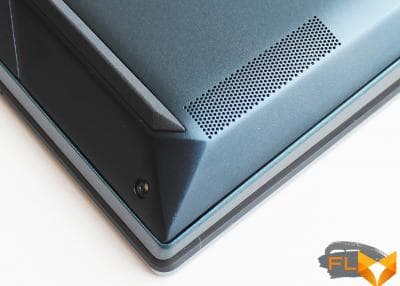 | 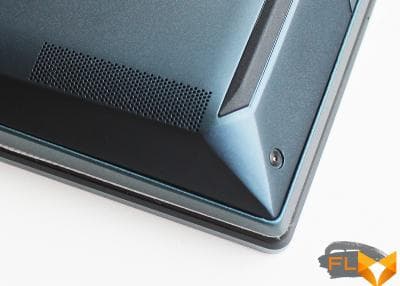 |
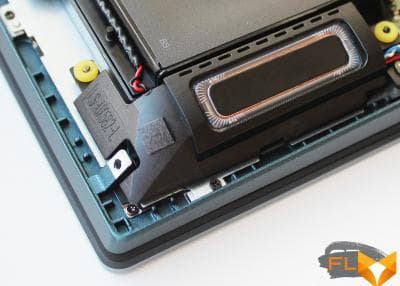 | 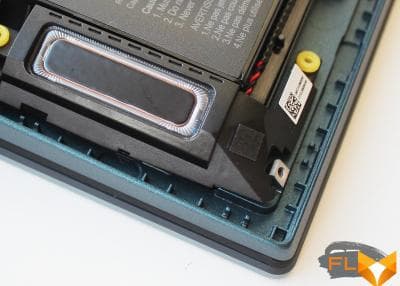 |
Subjectively, the sound is very loud and detailed. This is perhaps one of the highest quality audio systems in laptops of this size, even if the lack of low frequencies is also felt here.
All in the same MyASUS software package there is a separate section for activating microphone noise reduction and filtering the output through the acoustics of all sounds, except for the human voice.


A separate application on the laptop installed DTS Audio Processing with the ability to select the environment mode and a graphic equalizer.
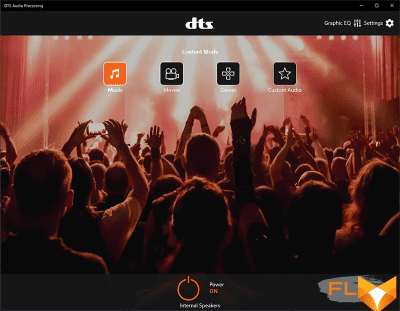 | 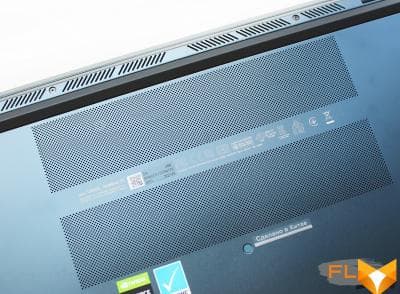 |
⇡#Cooling system, efficiency and noise level
The ASUS ZenBook Pro Duo 15 OLED UX582L is equipped with Active Aerodynamic System (AAS+) cooling system, which includes ErgoLift screen hinges that raise the secondary screen by 9.5 degrees, thereby increasing airflow by 36%.
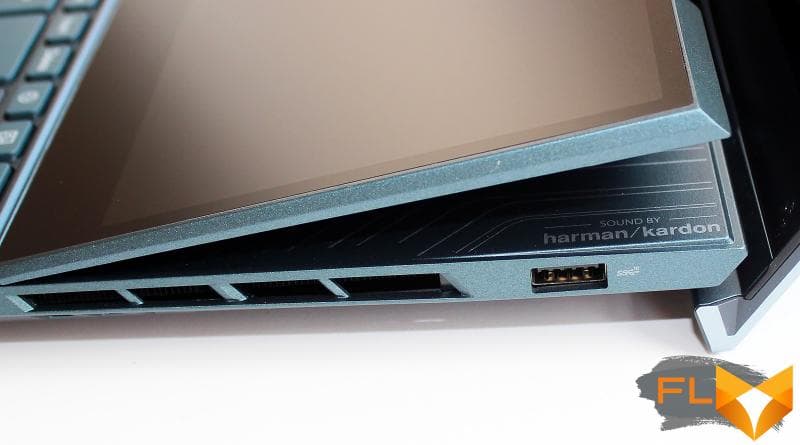
Cold air enters the laptop mainly from below, through two massive ventilation grilles.
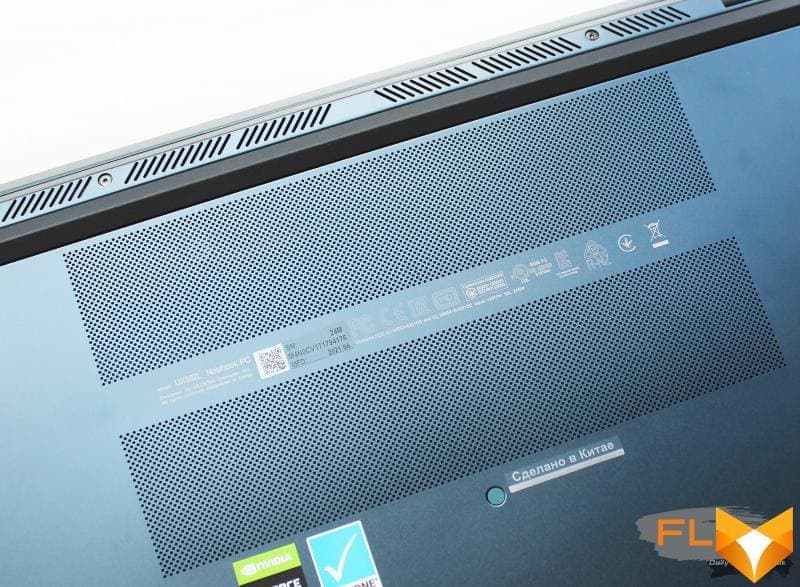
And the release of heated air occurs on the sides of the case and back, and in the stress test mode, a very hot air stream comes out of these gratings.
 | 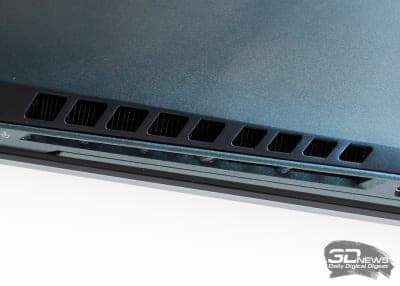 |
Six heat pipes, two radiators and two fans are directly responsible for cooling the central and graphics processors. Three heat pipes have a diameter of 8 mm, two – 6 mm and one – 5 mm. The fans are 97-blade, while the previous generation of ASUS ZenBook Pro Duo used 71-blade fans of the same diameter.
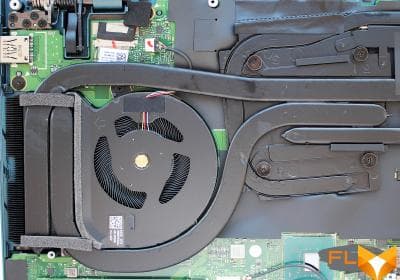 | 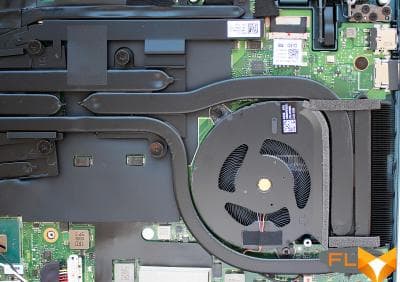 |
A liquid metal thermal interface is applied to the processor die, which, according to ASUS engineers, has reduced the CPU temperature by 10 degrees Celsius or even more when compared with a scenario where conventional thermal paste is used. For laptops, this is of particular importance, since the frequency of the processor, and hence the performance, directly depends on the temperature of the processor.
ASUS ZenBook Pro Duo 15 OLED UX582L has two operating modes in the MyASUS app: high performance and standard.

But in the ProArt Creator Hub application, these same modes are called “Rendering” and “Normal”. Here you can also activate the maximum fan speed mode and look at the monitoring data.
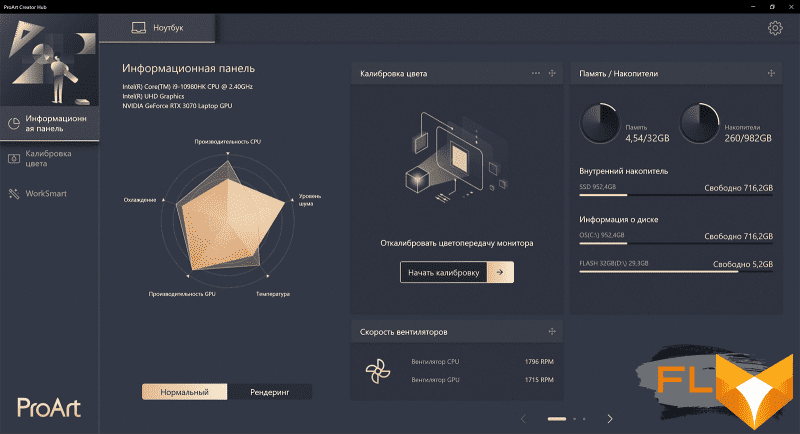
The LED strip in the front of the case will inform you about which particular mode of the laptop is activated.
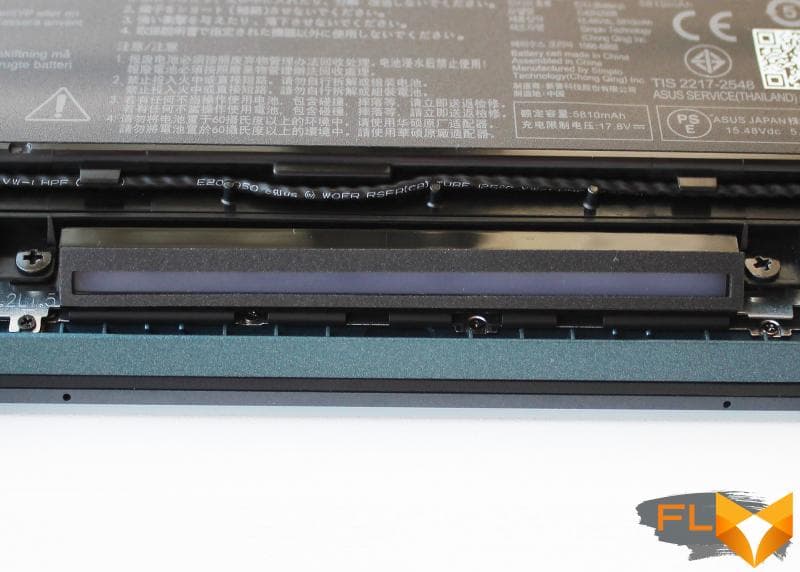
To evaluate the efficiency of CPU cooling in the ASUS ZenBook Pro Duo 15 OLED UX582L laptop, we used the FPU stress test from the AIDA64 Extreme utility version 6.33.5725 Beta. Monitoring of indicators was also provided by this utility. Testing conducted in hot weather, indoor temperature about 27.5 degrees Celsius, running Windows 10 Pro x64 with the latest drivers and updates available.
First, we tested the laptop while running on power adapter and mains power in two available modes.
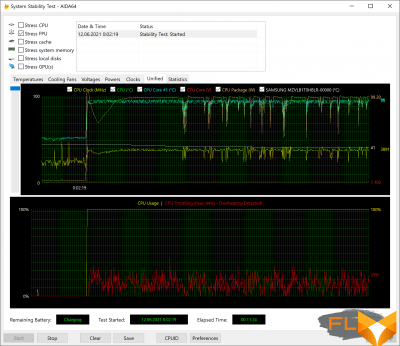 | 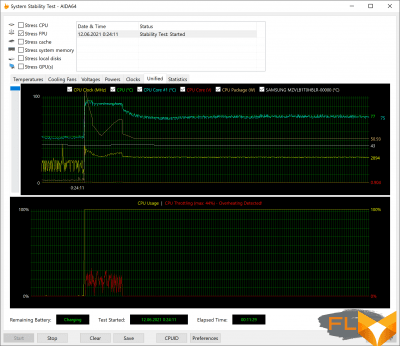 |
| High performance (3.9GHz, 93°C, 94W) | Standard (2.9GHz, 77°C, 51W) |
As you can see, the differences between these modes are very significant. At high performance, the laptop processor was permanently throttling, but still kept the frequency at 3.9 GHz at a temperature of 93 degrees Celsius and the heat dissipation of the entire system was 94 watts. The noise level and the degree of heating of the air emitted from the laptop are very high. In the standard mode, the eight-core processor activated the throttling mode only at the beginning of the test, but then, with a simultaneous decrease in frequency and an increase in the speed of the cooler fans, the frequency stabilized at 2.9 GHz at a temperature of about 77 degrees Celsius and a power consumption of 51 watts. In this case, the laptop’s cooling system is audible, but it does not cause any discomfort when working on it.
Now let’s repeat the stress test with the laptop running on battery power (Standard mode only).

Standard (2.8GHz, 73-75°C, 45W)
No throttling was observed here from the very beginning of the test, the processor frequency is around 2.8 GHz at a temperature of 73-75 degrees Celsius and a power consumption of 45 watts.
Next, we stress-tested the NVIDIA GeForce RTX 3070 Laptop GPU discrete graphics card, which was loaded with the Fire Strike Extreme looped benchmark from the 3DMark test suite.

And again, first we will show the test results of the laptop when powered from the mains in two modes.
| High performance (1.47GHz, 75°C, 98W) | Standard (1.24GHz, 74°C, 80W) |
Once again there is a difference. When the high performance mode is activated, the graphics processor of the video card keeps a frequency of 1.47 GHz at a temperature after stabilization of 75 degrees Celsius and a power consumption of 98 watts (sometimes increased to 110 watts). The noise level is again high, and the exhaust on the sides of the laptop can heat a small room. Much quieter is the “Standard” mode, where the GPU frequency stabilizes at 1.24 GHz at the same temperature and 80 watts of power consumption. The same mode becomes even more moderate when the laptop is running on battery power.

In this case, you can only count on 0.92 GHz for the GPU, and even the frequency of the video memory is reduced from 12 to 11 GHz. But the laptop is quiet, though not for long, which we will demonstrate in the autonomy section.
⇡#Performance testing
We compared the performance of the ASUS ZenBook Pro Duo 15 OLED UX582L to two gaming laptops: the Gigabyte AORUS 15G XC with an Intel Core i7-10870H processor and the ASUS ROG Strix SCAR 17 G733Q with an AMD Ryzen 9 5900HX processor. All laptops were tested in maximum performance mode when running on power adapter and mains. First, let’s look at the results of the processor and RAM tests.
| Test name | Indicator | ASUS ZenBook Pro Duo 15 OLED UX582L (Intel Core i9-10980HK) | Gigabyte Aorus 15G XC (Intel Core i7-10870H) | ASUS ROG Strix SCAR 17 G733Q (AMD Ryzen 9 5900HX) | |
| Announcement date and cost: | May 2021 $4,500 | January 2021 ~$2300 | January 2021 >$4,500 | ||
| AIDA64 memtest | Read | ↑ | 40 820 | 40 382 | 45 673 |
| Write | ↑ | 41 138 | 40 936 | 43 149 | |
| Copy | ↑ | 36 991 | 37 047 | 40 962 | |
| Latency | ↓ | 52.8 | 57.9 | 82,8 | |
| WinRAR | KB/s | ↑ | 21 587 | 20 883 | 22 044 |
| 7-Zip | MIPS | ↑ | 67 988 | 63 582 | 85 899 |
| HandBrake | H.265 MKV 4K, s | ↓ | 358,91 | 388,22 | 284,12 |
| CineBench R23 | CPU (Multi Core), pts | ↑ | 10 190 | 9 893 | 13 701 |
| CPU (Single Core), pts | ↑ | 1 312 | 1 231 | 1 468 | |
| Blender (Classroom) | Classroom, time | ↓ | 0:10:32 | 0:11:52 | 0:08:22 |
| Geekbench 5 | Single-Core Score | ↑ | 1 318 | 1 275 | 1 517 |
| Multi-Core Score | ↑ | 7 598 | 7 696 | 8 521 | |
| VeraCrypt (Kuznyechik (Serpent (Camellia) | Encryption, MiB/s | ↑ | 877 | 839 | 767 |
| Decryption, MiB/s | ↑ | 813 | 801 | 717 | |
| PCMark’10 | Total | ↑ | 5 936 | 6 516 | 7 081 |
| Essentials | ↑ | 9 320 | 9 610 | 10 044 | |
| Productivity | ↑ | 7 419 | 8 845 | 9 498 | |
| Digital Content Creation | ↑ | 8 209 | 8 836 | 10 103 | |
| 3DMark | Night Raid | ↑ | 26 353 | 45 830 | 46 725 |
| Fire Strike | ↑ | 18 692 | 19 895 | 25 017 | |
| Wild Life | ↑ | 17 192 | 47 743 | 55 873 | |
| World of Tanks enCore RT (среднее качество) | Score | ↑ | 75 894 | 69 856 | 64 829 |
| CompuBench 2.0 (Cuda) | Level-set Sim. 256, MVoxels/s | ↑ | 10 708,9 | 10 719,7 | 13 785,0 |
| Ocean Surface Sim., It./s | ↑ | 4 527,1 | 4 939,7 | 4 737,2 | |
| TV-L1 Optical Flow, Mpixels/s | ↑ | 67,680 | 63,554 | 81,684 | |
| GFXBench 5 (DX11) | Aztec Ruins (High Tier), Frames | ↑ | 6 124,29 | 20 279,70 | 24 241,30 |
| ALU, Frames | ↑ | 1 794,28 | 7 195,28 | 8 986,40 | |
| Render Quality, mB PSNR | ↑ | 4 541,60 | 2 493,75 | 2 493,75 | |
With the exception of a couple of tests, the ASUS ZenBook Pro Duo 15 OLED UX582L turned out to be slightly faster than the Gigabyte AORUS 15G XC, but still significantly slower than the ASUS ROG Strix SCAR 17 G733Q, which, however, is not surprising, because in multi-threaded performance, the mobile AMD Ryzen 9 5900HX is simply equal no. By the way, if the UX582L had faster RAM with low latency, the gap from the leader would be less. But, alas, apparently, we will not wait until the moment when memory with a frequency of more than 3.2 GHz and CL16 will be installed in the most expensive laptops.
Now it’s time for gaming tests. The composition of the participants is the same, all games were tested at a resolution of 1920 × 1080 pixels at maximum quality settings, but without using any anti-aliasing techniques.
| Benchmarks and games (Full HD, maximum quality) | Points/FPS | ASUS ZenBook Pro Duo 15 OLED UX582L (NVIDIA GeForce RTX 3070 Laptop GPU) ~296 thousand rubles . | Gigabyte AORUS 15G XC (NVIDIA GeForce RTX 3070 Laptop GPU) ~150K RUB strong> | ASUS ROG Strix SCAR 17 G733 (NVIDIA GeForce RTX 3080 Laptop GPU) RUB 279K |
| Fire Strike Extreme | 10 610 | 10 513 | 13 834 | |
| Time Spy | 8 856 | 8 485 | 10 978 | |
| Port Royale (DLSS) | 5 350 | 5 183 | 6 782 | |
| Neon Noir Ray Tracing Bench | 1080P Ultra | 9 342 | 9 716 | 11 192 |
| OctaneBench 2020.1.5 | Score | 326,73 | 354.82 | 416.65 |
| V-Ray GPU RTX | Vrays | 1453 | 1417 | 1 673 |
| World of Tanks enCore RT | 1080P Ultra | 24 509 | 24 520 | 29 386 |
| F1 2018 | Medium | 143 | 144 | 144 |
| Minimum | 106 | 103 | 112 | |
| Strange Brigade | Medium | 167 | 159 | 176 |
| Minimum | 75 | 66 | 65 | |
| Shadow of the Tomb Raider | Medium | 77 | 70 | 89 |
| Minimum | 58 | 50 | 65 | |
| Metro Exodus (Ultra) | Medium | 66 | 69 | 87 |
| Minimum | 38 | 36 | 45 | |
| Metro Exodus (RTX) | Medium | 56 | 58 | 74 |
| Minimum | 33 | 34 | 42 | |
| Far Cry New Dawn | Medium | 93 | 88 | 81 |
| Minimum | 52 | 62 | 55 | |
| World War Z | Medium | 142 | 114 | 145 |
| Minimum | 108 | 81 | 112 | |
| Chernobylite | Medium | 81 | 79 | 95 |
| Minimum | 42 | 43 | 52 | |
| Gears Tactics | Medium | 112 | 101 | 128 |
| Minimum | 95 | 91 | 96 | |
| Horizon Zero Dawn | Medium | 71 | 84 | 99 |
| Minimum | 36 | 46 | 49 | |
| Zombie Army 4: Dead War | Medium | 143 | 137 | 160 |
| Minimum | 72 | 67 | 81 | |
| Total War Saga: TROY | Medium | 84 | 85 | 88 |
| Minimum | 69 | 69 | 74 | |
| Red Dead Redemption 2 | Medium | 68 | 54 | 72 |
| Minimum | 31 | 38 | 32 | |
| Serious Sam 4 | Medium | 77 | 72 | 78 |
| Minimum | 32 | 30 | 32 | |
| Assassin’s Creed Valhalla | Medium | 70 | 64 | 75 |
| Minimum | 35 | 34 | 44 | |
| Immortals Fenyx Rising | Medium | 70 | – | 74 |
| Minimum | 31 | – | 38 | |
| Final result by games | Medium | 95.0 | 91.9 | 104.1 |
| Minimum | 57.1 | 56.1 | 62.1 |
Both laptops with the NVIDIA GeForce RTX 3070 Laptop GPU showed about the same performance, but the ASUS ZenBook Pro Duo 15 OLED UX582L is still slightly ahead in dry numbers. And this is despite the denser layout and additional screen. The second ASUS laptop is about 10% faster than the hero of today’s test, which does not really matter on the scale of this test. Overall, the performance of the ZenBook Pro Duo 15 OLED UX582L is at a very high level.
⇡#Autonomous
The laptop comes with a 240 W (20.0 V, 3.5 A) ADP-240EB power adapter, weighing 559 grams, with a built-in 1.18 m cable and a separate 1.75 m power cable.

The notebook is equipped with a lithium-ion battery with a capacity of 92 Wh (5984 mAh).



After three full charge cycles from 3% to 99%, the average time was 1 hour 43 minutes. In our opinion, this is an excellent result for such a capacity. Note that MyASUS has three battery charge modes: full capacity, balanced (recommended) and maximum life mode, each of which is recommended for use in different laptop operating conditions.

First of all, we tested the autonomy of the laptop with the brightness of the main OLED display at 200 cd / m2 (74% on the brightness scale) and the ScreenPad Plus display turned off. Testing was carried out using the PCMark’10 package in Modern Office and Applications modes. Network connections and sound did not turn off. The results were pleasantly surprising for such a powerful machine: 9 hours 30 minutes in Modern Office mode and 6 minutes longer in Applications mode.
| PCMark’10 “Modern Office” (9 hours 30 minutes) | PCMark’10 “Applications” (9 hours 36 minutes) |
Already expecting your dissatisfied comments, we next activated the second ScreenPad Plus display at 70% brightness and ran the same two tests again. It turned out that the battery life in the Modern Office test was reduced by 3 hours 32 minutes to 5 hours 58 minutes, and in the Applications test the loss was slightly less – 3 hours 27 minutes with a final 6 hours 9 minutes.
| PCMark’10 “Modern Office” (5 hours 58 minutes) | PCMark’10 Applications (6h09) |
Roughly speaking, you can work with two active displays on the ASUS ZenBook Pro Duo 15 OLED UX582L for 6 hours.
In games (if you are not a tester) and when playing full-screen video, a second display is unlikely to be needed, so the two remaining autonomy tests – Gaming and Video – were carried out only with the active OLED.
| PCMark’10 “Gaming” (1hr 19min) | PCMark’10 “Video” (7h 39m) |
It turned out that you can play on this laptop for an hour and a third, and you can watch videos for almost 8 hours. If, in the latter case, reduce the display brightness from 200 to 100 nits, then you can additionally get about an hour of battery life.
⇡#Conclusion
With the new ZenBook Pro Duo 15 OLED UX582L, ASUS has actually created an uncompromising harvester capable of absolutely any task. Yes, it cannot be called light and truly mobile. Yes, it heats up in maximum performance mode and makes noise. And yes, it turned out to be expensive, like any other flagship product. But it’s the only one currently equipped with two 4K touchscreen displays, one of which is a 15.6-inch OLED with stunning image quality and color reproduction, while ErgoLift screen hinges lift the secondary ScreenPad Plus display when the main display is opened, creating a single workspace.
You might think that this is a laptop exclusively for designers and developers, for those who need to bring various menus, controls, active panels and other windows overloading the main display to the secondary display. This is true, but without the word “exceptional”, as the most powerful laptop hardware configuration, including an octa-core processor, a mobile GeForce RTX 3070, 32 GB of RAM and a 1 TB SSD, is suitable for any game in a user-friendly mode in terms of FPS.
Despite such serious components, the ZenBook Pro Duo 15 OLED UX582L is also suitable for battery life. Even with two active displays, you can spend 6 hours behind it away from the outlet, and using only the main display – all 9 hours. In addition, there is Wi-Fi 6, there is Thunderbolt 3, a rugged MIL-STD-810H-certified case, a stylus, two stands, a case, a NumberPad, amazing sound for a laptop, a webcam, and many small but useful features. It lacks a card reader and another USB Type-A port, well, you will need to get used to the narrow arrows on the keyboard. Otherwise, this is definitely a laptop that was ahead of its time.
FAQ Asus zenbook pro duo 15 oled ux582l laptop review
What distinguishes the UX582’s OLED screen from other laptops?
The UX582’s OLED screen stands out with its vibrant 4K OLED display, offering exceptional color accuracy and contrast, making it highly suitable for content creators and professionals who require precise color representation.
How does the dual-screen feature of the UX582 enhance its usability?
The dual-screen feature of the UX582, a hallmark of the ZenBook Duo series, offers added screen real estate, facilitating multitasking and improving workflow efficiency, especially for creative and professional work.
What are the key specs of the Pro Duo 15 OLED UX582?
The Pro Duo 15 OLED UX582 boasts a 15.6-inch 4K OLED main screen, Intel Core i9-10980HK CPU, NVIDIA GeForce RTX 3070 GPU, and up to 32GB of RAM, positioning it as a high-performance workstation.
Is the Duo 15 OLED UX582 laptop suitable for gaming?
Yes, the Duo 15 OLED UX582 is suitable for gaming, thanks to its RTX 3070 GPU and vibrant OLED display, which provide excellent graphics performance and visual experience, appealing to both gamers and content creators.
How does the ZenBook Duo Pro 15 compare with the Dell XPS 15 and ROG Zephyrus Duo?
The ZenBook Duo Pro 15, with its dual-screen setup and 4K OLED display, is more tailored towards multitasking and content creation, while the Dell XPS 15 is known for its premium build and the ROG Zephyrus Duo for its gaming-centric features.
The UX582’s combination of a 4K OLED screen, high-spec hardware including the Intel Core i9 processor and RTX 3070 GPU, and the unique dual-screen design make it a premium laptop choice for content creators.
How does the 32GB of RAM in the UX582 contribute to its performance?
32GB of RAM in the UX582 greatly enhances its multitasking capabilities, allowing it to handle multiple demanding applications simultaneously, crucial for professional-grade content creation and editing.
What are the customer reviews saying about the 15 UX582L’s performance and display?
Customer reviews of the 15 UX582L often highlight its powerful performance, courtesy of its high-end specs, and the exceptional quality of its 4K OLED display, making it highly favored among demanding users.
Does the Pro Duo’s high price point reflect its value in the laptop market?
The Pro Duo’s high price point is reflective of its advanced features, such as the dual-screen setup, 4K OLED panel, and top-tier hardware, positioning it as a high-end choice for professionals and creators.
How does the UX582 compare with the Razer Blade 15 Advanced in the gaming laptop world?
In the gaming laptop world, the UX582 stands out with its dual-screen feature and 4K OLED display, while the Razer Blade 15 Advanced is known for its gaming-focused design and performance. The UX582 is more versatile, catering to both gamers and content creators.
What makes a dual-screen laptop like the ASUS ZenBook Duo unique?
Dual-screen laptops offer an extended workspace, with the second screen enhancing productivity and multitasking capabilities, ideal for creative professionals and power users.
Is 16GB of RAM sufficient for running advanced applications on Windows 11 Pro?
Yes, 16GB of RAM is generally sufficient for running most advanced applications smoothly on Windows 11 Pro, including multitasking and resource-intensive tasks.
Why is the Duo 15 considered a good choice for creative professionals?
The Duo 15 is a good choice for creative professionals due to its dual-screen setup, powerful hardware including the RTX 3070 GPU with 8GB, and support for demanding software like Premiere Pro.
How does the 4K screen enhance the user experience on laptops?
A 4K screen on laptops provides higher resolution and sharper details, greatly enhancing the user experience, especially for visual content, graphic design, and high-definition video viewing.
In your experience, what sets the latest generation Intel Core processors apart in laptops?
The latest gen Intel Core processors in laptops offer improved performance, faster processing speeds, and better energy efficiency, enhancing overall laptop performance.
What are the common concerns about battery life in high-performance laptops?
High-performance laptops often have disappointing battery life due to the high power consumption of their advanced components, such as powerful CPUs and GPUs, and high-resolution screens.
How essential is a laptop stand for dual-screen laptops?
A laptop stand can be essential for dual-screen laptops, like the 14-inch ZenBook Duo 14, as it elevates the laptop for better ergonomics and cooling, enhancing the dual-screen viewing experience.
Can you describe the design and build quality of the ASUS ZenBook Pro Duo?
The ASUS ZenBook Pro Duo features a premium design with celestial blue brushed magnesium-aluminum construction, offering a sturdy build quality and an aesthetically pleasing look.
How does the RTX 3070 GPU with 8GB enhance the ASUS Pro Duo’s performance?
The RTX 3070 GPU with 8GB in the ASUS Pro Duo enhances its performance significantly, providing powerful graphics capabilities for gaming, video editing, and 3D rendering.
Is the ASUS ZenBook Duo 14 suitable for professional video editing software like Premiere Pro?
The ASUS ZenBook Duo 14, with its dual-screen setup and capable hardware, is suitable for professional video editing software like Premiere Pro, offering ample screen space and processing power for such tasks.
